DragonWave DWR24-000001 24 GHz Air Pair Point-Point Radio Unit User Manual AirPair Product Manual GHz version 1 0 030325
DragonWave Inc. 24 GHz Air Pair Point-Point Radio Unit AirPair Product Manual GHz version 1 0 030325
Users Manual
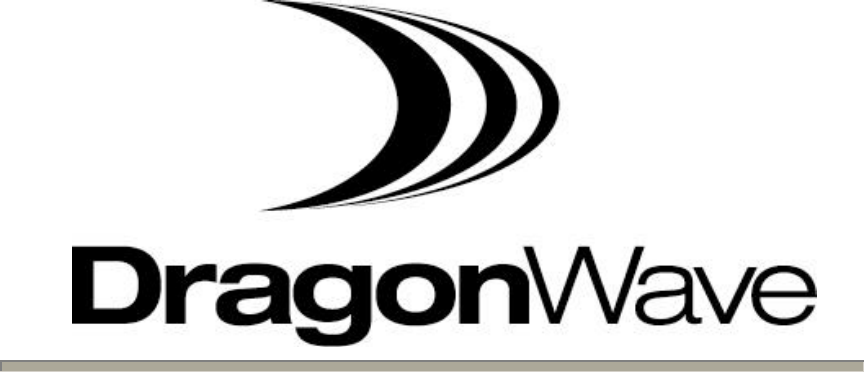
AirPairTM
100-UL
High-Capacity 24 GHz Unlicensed Band Wireless Ethernet
System Product Manual
Version 1.0
This page is intentionally left blank.
NOTICE
This document contains confidential information, which is proprietary to
DragonWave. No part of its contents can be used, copied, disclosed, or
conveyed to any party in any manner whatsoever without prior written permission
from DragonWave Inc.
Copyright © 2001-2003 DragonWave Inc. All Rights Reserved. Printed in
Canada.

DragonWave Inc. iv
This page is intentionally left blank.
Table of Contents
1. INTRODUCTION ...........................................................................................................1
1.1.....REFERENCES...................................................................................................................................................2
1.2.....ICONS...............................................................................................................................................................3
2. SAFETY AND REGULATORY COMPLIANCE................................................................4
2.1.....SAFETY INFORMATION..................................................................................................................................4
2.1.1. SAFETY INFORMATION FOR DRAGONWAVE’S AIRPAIRTM...............................................................4
2.1.2. INSTALLATIONS..........................................................................................................................................4
2.1.3. LIGHTNING PROTECTION..........................................................................................................................4
2.1.4. ELECTROCUTION HAZARD.......................................................................................................................5
2.2.....REGULATORY COMPLIANCE INFORMATION..............................................................................................5
2.2.1. FEDERAL COMMUNICATION COMMISSION DECLARATION OF CONFORMITY STATEMENT.............5
2.2.2. PROFESSIONAL INSTALLATION................................................................................................................6
3. WARRANTY.................................................................................................................7
3.1.....GENERAL TERMS...........................................................................................................................................7
3.2.....HARDWARE ....................................................................................................................................................7
3.3.....SOFTWARE......................................................................................................................................................8
3.4.....RETURN OF EQUIPMENT UNDER WARRANTY...........................................................................................8
3.5.....DEFAULT AND TERMINATION......................................................................................................................9
3.6.....FORCE MAJEURE..........................................................................................................................................10
3.7.....ENGINEERING AND SYSTEM DESIGN ........................................................................................................10
4. DESCRIPTION............................................................................................................11
4.1.....AIRPAIR 100-UL SPECIFICATIONS............................................................................................................12
4.2.....CALCULATING THE LINK BUDGET ............................................................................................................12
4.2.1. POWER OUTPUT .......................................................................................................................................13
4.3.....COMMAND LINE INTERFACE......................................................................................................................13
4.3.1. CONFIGURING THE SERIAL PORT USING THE CLI ...............................................................................13
4.3.2. CREATE LOGIN ACCOUNT ......................................................................................................................15
4.4.....SET AIRPAIR FREQUENCY..........................................................................................................................18
4.5.....SET AIRPAIR CUSTOM FREQUENCY SETTINGS .......................................................................................23
4.6.....SET IP ADDRESS ...........................................................................................................................................29
4.7.....VLAN TAGGING..........................................................................................................................................32
5. INSTALLATION..........................................................................................................35
5.1.....BEFORE YOU BEGIN.....................................................................................................................................35

DragonWave Inc. vi
5.2.....MOUNTING SPECIFICATIONS......................................................................................................................35
6. INSTALLATION OF RADIO AND MODEM ...................................................................37
6.1.....MOUNTING THE RADIO AND ANTENNA ONTO THE MOUNTING BRACKET ..........................................37
6.2.....VISUALLY-ALIGNING RADIOS....................................................................................................................39
6.3.....FINE-ADJUST ALIGNMENT OF THE RADIOS...............................................................................................46
6.3.1. MAIN LOBE AND SIDE LOBES OF RADIO WAVES................................................................................46
6.4.....CLEAR LINE OF SIGHT.................................................................................................................................48
6.5.....FINE-ADJUST ALIGN THE RADIOS...............................................................................................................50
6.5.1. PERFORM A DATA TEST..........................................................................................................................53
6.5.2. CONNECT TO THE LAN...........................................................................................................................53
7. SETTING UP THE SNMP ............................................................................................55
7.1.1. AIRPAIR ENTERPRISE MANAGEMENT INFORMATION BASE..............................................................57
7.1.2. TRAPS........................................................................................................................................................57
8. TECHNICAL SUPPORT ..............................................................................................61
9. NOTICE......................................................................................................................63
9.1.....COPYRIGHT...................................................................................................................................................63
APPENDIX A – FREQUENCY CHANNEL PLANS ...........................................................65
APPENDIX B – MOUNTING INSTRUCTIONS FOR 30 CM, 45 CM, 60 CM, 90CM, 120 CM
ANTENNAS ...................................................................................................................67

List of Procedures
vii
List of Procedures
Procedure 4-1 Configuring the Serial Port using the CLI......................................... 13
Procedure 4-2 Create Login Account........................................................................... 16
Procedure 4-3 Set AirPair Frequency available and Transmit Power...................... 18
Procedure 4-4 Setting the 24GHz AirPair Frequency channels for user-defined
custom frequency pairs.......................................................................................... 23
Procedure 4-5 Setting the IP Address......................................................................... 30
Procedure 4-6 Setting VLAN Tag................................................................................. 33
Procedure 6-1 Mounting the 12″and 18″ antennas..................................................... 37
Procedure 6-2 Visually align the radios....................................................................... 39
Procedure 6-3 Attaching the Modem to Mounting Bracket....................................... 39
Procedure 6-4 Connecting the IF and RS-232 cable to the modem and radio ........ 43
Procedure 6-5 Connect the power cable to the modem and the power pack ......... 45
Procedure 6-6 Fine-adjust Align Radios ...................................................................... 51
Procedure 6-7 Perform a data test................................................................................ 53
Procedure 7-1 Setting up SNMP.................................................................................... 55
Procedure 7-2 Enable traps........................................................................................... 57

DragonWave Inc. viii
This page is intentionally left blank.
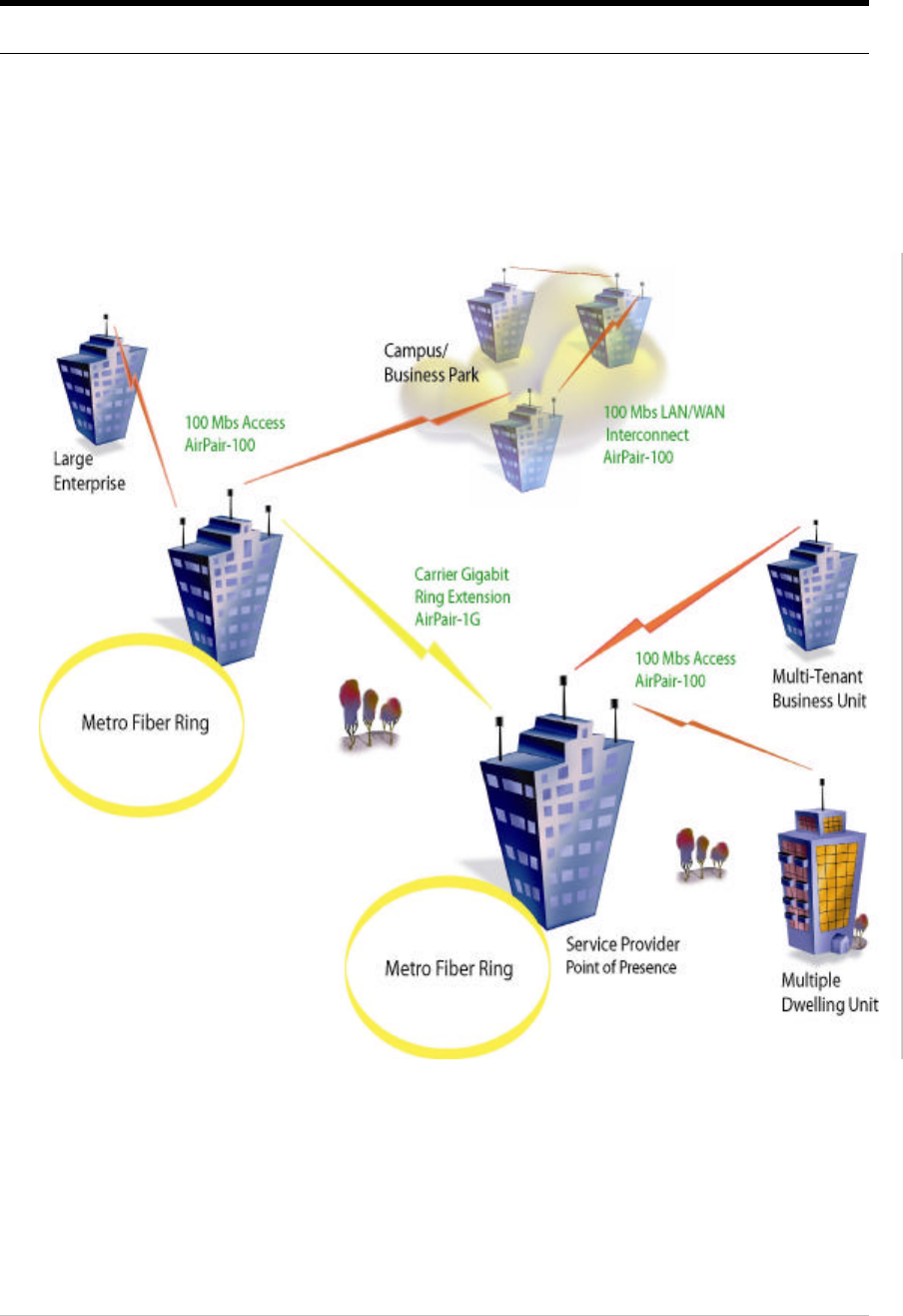
1. Introduction
This manual describes both the DragonWave AirPairTM 50 system and the
AirPairTM 100 system. Use this manual to learn how to install and configure the
DragonWave AirPairTM 50 and AirPairTM 100 systems.
This document refers to the AirPair 50 and AirPair 100 systems as the AirPairTM.
Figure 1-1
DragonWave AirPair Systems

DragonWave Inc. 2
AirPair 100 UL 24 GHz Product Manual
1.1. References
This document refers to the following documents:
• Cleveland, Robert F., Jr., David M. Sylvar and Jerry L. Ulcek. OET Bulletin
65.Evaluating Compliance with FCC Guidelines for Human Exposure to
Radiofrequency Electromagnetic Fields, Edition 97-01, August 1997.
• ET Docket No. 96-8, RM8165. April 10, 1997. Amendment of Parts 2 and 15 of the
Commission's Rules Regarding Spread Spectrum Transmitters. FCC.
• Institute of Electrical and Electronics Engineers (1992). IEEE Standard for safety
levels with respect to human exposure to radio frequency electromagnetic fields, 3
kHz to 300 GHz. ANSI Standard C95.1-1991. New York, NY.
• Institute of Electrical and Electronics Engineers (2002). IEEE Standard 802.1Q
Virtual Bridged Local Area Networks: Multiple Spanning Trees. New York, NY.
• National Electrical Code (NEC), Chapter 800, Article 810, Radio and Television
Equipment.
• Radio Waves Inc. Mounting Instructions for 1 ft, 1.5 ft and 2ft Antenna.
• Radio Waves Inc. Mounting Instructions for 90 cm and 120 cm.
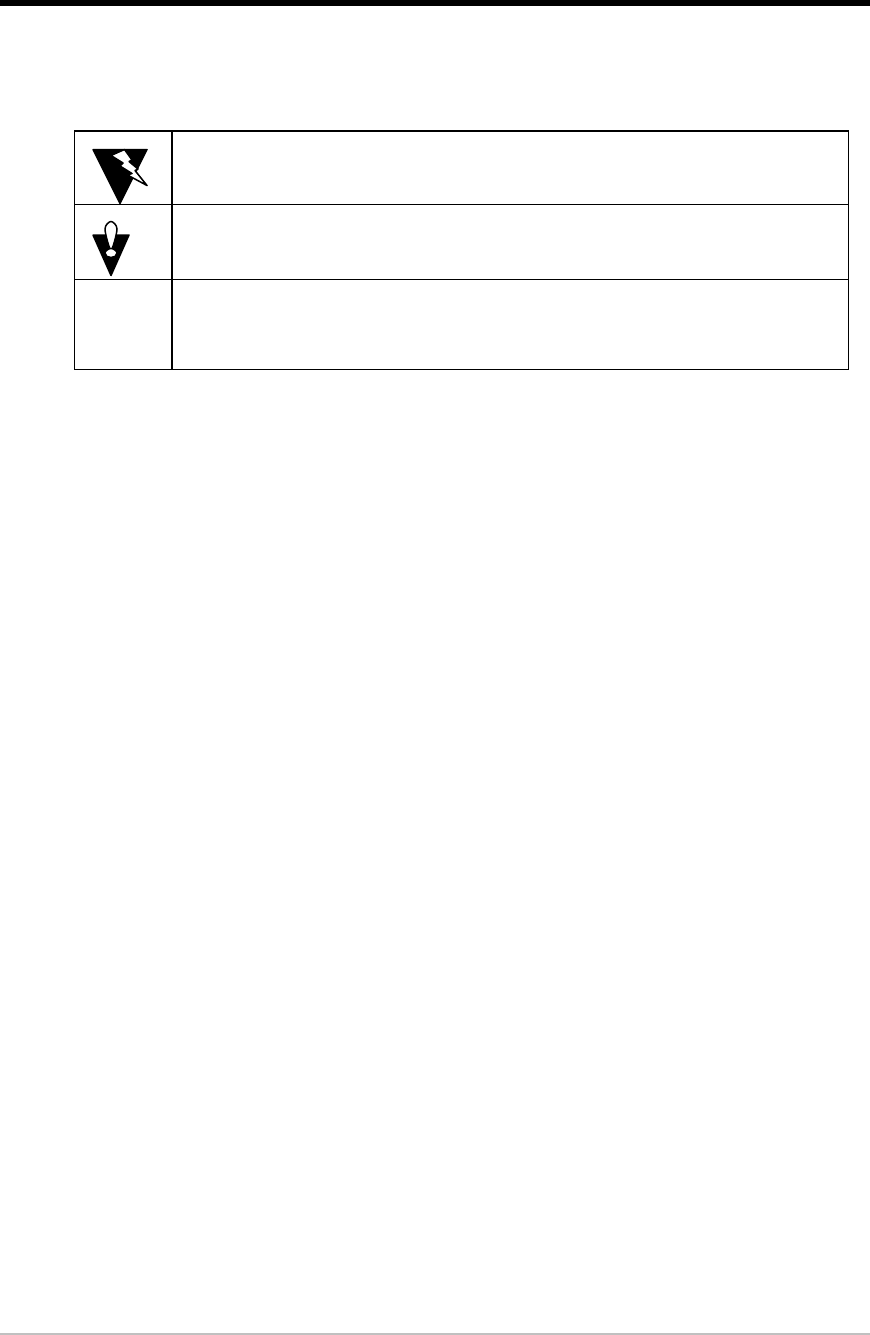
Introduction
3
Version 1.0
1.2. Icons
The following icons appear in this manual and highlight areas of special interest
and importance.
Warning
Cause Bodily Harm
Caution
Cause damage to equipment or service outage
i
Information or Note
Important Information

2. Safety and Regulatory Compliance
This section details safety issues and regulatory compliance.
2.1. Safety Information
2.1.1. Safety Information for DragonWave’s AirPairTM
The Federal Communications Commission (FCC), with its action in ET Docket
96-8, has adopted a safety standard for human exposure to radio frequency (RF)
electromagnetic energy emitted by FCC-certified equipment. DragonWave
AirPairTM meets the uncontrolled environmental limits found in OET-65 and
ANSI C95.1, 1991. Proper operation of this radio according to the instructions
found in this manual and the users guide for the DragonWave AirPairTM product
will result in user exposure that is substantially below the FCC recommended
limits.
• Do not touch or move antenna(s) while the unit is transmitting or
receiving.
• While transmitting, do not hold any component containing the
radio in such a way that the antenna is very close to or touching
any exposed parts of the body, especially the face or eyes.
• Do not operate a portable transmitter near unshielded blasting
caps or in an explosive environment unless it is a type especially
qualified for such use.
The design of the high-gain mast mount antennas is such that professional
installation is required.
2.1.2. Installations
DragonWave AirPairTM devices require professional installation. It is the
responsibility of the installer to be sure that all building and safety codes are met
and that the installation is complete and secure.
For Canadian installations, the entire equipment installation must comply with
Canadian Standard CSA 22.2, No. 60950, Safety of Information Technology
Equipment. For installations in the United States, the entire equipment
installation must be in accordance with Article 810 of the United States National
Electrical Code.
2.1.3. Lightning Protection
When installed, this equipment is to be connected to a Lightning/Surge
Protection Device that meets all applicable national safety requirements.
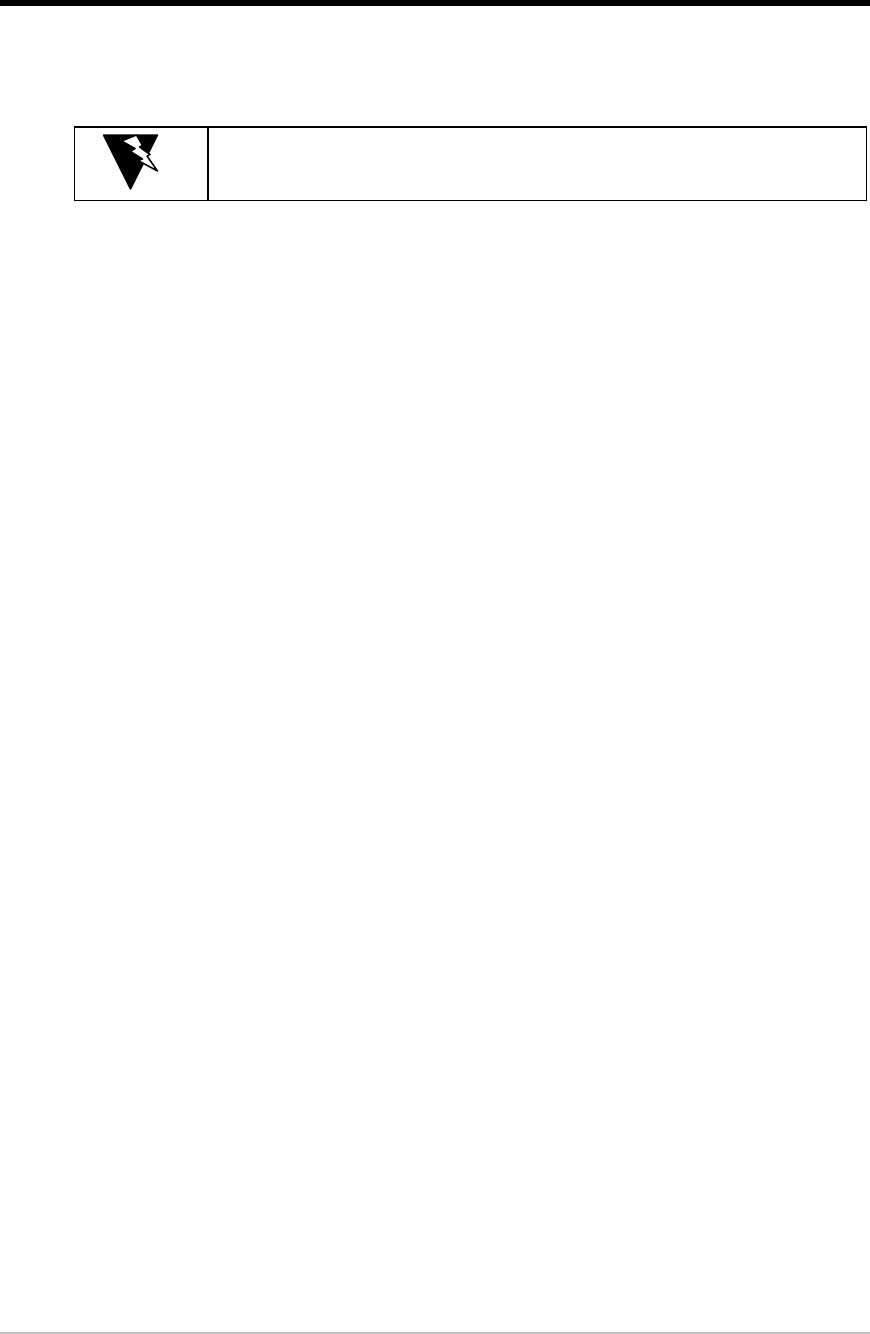
Safety and Regulatory Compliance
5
Version 1.0
2.1.4. Electrocution Hazard
Warning
Electrocution Hazard
This product is intended to be connected to a –48v dc power source (supplied by
DragonWave Inc.), which must be electrically isolated from any ac sources and
reliably connected to Earth ground. Do not install DragonWave products near any
type of power line. Should your antenna or related hardware come in contact with
power lines, severe bodily harm or death could result!
2.2. Regulatory Compliance Information
This section contains information regarding regulatory compliance with the
Federal Communication Commission, Department of Communications and the
European Telecommunications Standards Institute applies to the DragonWave
AirPairTM Radio Link.
2.2.1. Federal Communication Commission Declaration of Conformity
Statement
This device complies with Part 15 of FCC Rules. Operation is subject to the
following two conditions: (1) This device may not cause harmful interference,
and (2) This device must accept any interference received, including interference
that may cause undesired operation.
This equipment has been tested and found to comply with the limits of a Class B
digital device, pursuant to Part 15 of FCC Rules. These limits are designed to
provide reasonable protection against harmful interference in a residential
installation. This equipment generates and can radiate radio-frequency energy
and, if not installed and used in accordance with the instructions, may cause
harmful interference to radio communications. However, there is no guarantee
that interference will not occur in a particular installation. If this equipment does
cause harmful interference to radio or television reception, which can be
determined by turning the equipment off and on, the user is encouraged to try to
correct the interference by one or more of the following measures.
• Reorient or relocate the receiving antenna
• Increase the separation between the equipment and receiver
• Connect the equipment into an outlet on a circuit different from
that to which the receiver is connected
• Consult the dealer or an experienced radio/TV technician for help
Any changes or modifications not expressly approved by the party responsible
for compliance could void the user’s authority to operate the equipment.

DragonWave Inc. 6
AirPair 100 UL 24 GHz Product Manual
Warning
The Part 15 radio device operates on a non-
interference basis with the other devices operating at
this frequency. Any changes or modification to said
product not expressly approved by DragonWave Inc.
could void the user’s authority to operate this device.
2.2.2. Professional Installation
As per the recommendation of the FCC, the installation of high-gain directional
antennas to the system, which is intended to operate solely as a point-to-point
system and whose total power exceeds the +36 dBm Effective Isotropic Radiated
Power (EIRP), requires professional installation. It is the responsibility of the
installer and the end user that the high power systems are operated strictly as a
point-to-point system.
Systems operating as a point-to-multipoint system or using non-directional
antennas cannot exceed +2500 mV/m measured at 3 meters under any
circumstance and do not require professional installation.

3. Warranty
This section describes the warranty.
3.1. General Terms
(a) All Definitions contained in DragonWave Inc.’s Terms and Conditions of
Sale apply to the Warranty.
(b) This Warranty applies to all original purchases of DragonWave Inc.
manufactured equipment and accessories (collectively “Equipment”).
(c) This Warranty applies to the specifications contained in the most recent
version of the manual for the model of Equipment purchased.
(d) This Warranty does not apply to the following items of Equipment:
i. cables and connectors;
ii. visual alignment tool;
iii. fine adjust alignment tool; or
iv. non-DragonWave Inc. equipment or equipment that is not listed in
DragonWave Inc.’s price book.
(e) The Customer acknowledges that DragonWave Inc. does not represent or
warrant that the services provided by DragonWave Inc. under this
Warranty will ensure uninterrupted or error-free operation of the
Equipment.
(f) The effective period of this Warranty shall start on the date of shipment of
the Equipment and shall end twelve (12) months later.
3.2. Hardware
(a) DragonWave Inc. warrants that the Equipment, which is hardware, will be
free from defects in material and will comply with DragonWave Inc.’s
normal standards of workmanship, for a period of twelve (12) months
from the date of shipment.
(b) DragonWave Inc. shall incur no liability under the foregoing warranty
unless:
i. the allegedly defective Equipment is returned, prepaid, to
DragonWave Inc. within fifteen (15) days of the date of discovery
of the alleged defect, in accordance with DragonWave Inc.’s then
current repair procedures; and
ii. DragonWave Inc.’s tests disclose that the alleged defect is due
solely to defects in material or workmanship.
(c) The liability of DragonWave Inc. under this hardware warranty shall in any
event be limited, at DragonWave Inc.’s option and expense, to either the
repair or replacement of the defective Equipment, or the reimbursement
of the purchase price by the Customer to DragonWave Inc. for the
defective Equipment.

DragonWave Inc. 8
AirPair 100 UL 24 GHz Product Manual
(d) In no event will DragonWave Inc. be liable for damage to the Equipment
resulting from improper handling during or after shipment, misuse,
neglect, improper installation, operation or repair (other than by
authorized DragonWave Inc. personnel), alteration, accident, or for any
other cause not attributable to defects in materials or workmanship on the
part of DragonWave Inc.
3.3. Software
(a) DragonWave Inc. warrants that any software supplied as a Product or as
part of a Product will function substantially in accordance with the
functional description set out in the software documentation provided to
the Customer for a period of ninety (90) days from the date of shipment to
the Customer.
(b) DragonWave Inc.’s sole obligation and the Customer’s sole remedy for a
breach of this warranty shall be DragonWave Inc.’s good faith efforts to
rectify the non-conformity, or, if after reasonable efforts, DragonWave Inc.
is unable to rectify the non-conformity, DragonWave Inc. shall accept
return of the software and refund to Customer the purchase price thereof.
This warranty is available only once in respect of each licensed software
program. DragonWave Inc. shall have no obligation under this warranty if
the software is modified or if the software is used with hardware or
software not supplied or approved by DragonWave Inc.
(c) In no event shall DragonWave Inc.’s liability to the Customer or to any
other party for breach of any of the foregoing warranties exceed the
purchase price paid by the Customer to DragonWave Inc. for the
defective hardware or software product.
(d) The express warranties set out in this warranty statement are in lieu of all
other warranties, representations or conditions, expressed or implied,
including implied warranties of merchantability or fitness for a particular
purpose, or those arising from statute or usage of trade. The Customer
shall not make any representations or warranties of any kind whatsoever
relating to the Equipment or to DragonWave Inc. which exceed those
made by DragonWave Inc. in this warranty statement.
3.4. Return of Equipment Under Warranty
(a) If an item of Equipment malfunctions or fails in normal intended usage
and maintenance within the applicable Warranty Period:
i. the Customer shall promptly notify DragonWave Inc. of the
problem and the serial number of the defective item; and
ii. DragonWave Inc. shall, at its sole option, either resolve the
problem over the telephone or provide the Customer with a
Returned Materials Authorization (RMA) number and the address
of the location to which the Customer can ship the defective item.

Warranty
9
Version 1.0
(b) If the problem is not resolved over the telephone, the Customer shall
attach a DragonWave Repair and Return Form to each returned item
describing the fault and the Customer’s return address. The Customer
shall, at its cost, properly pack the item to be returned, prepay the
insurance and shipping charges, and ship the item to the specified
location.
(c) If the DragonWave Inc. equipment shall prove to be defective in material
or workmanship upon examination by DragonWave Inc., DragonWave
Inc. shall either repair or replace the returned item at its sole option. The
replacement item can be new or refurbished; if refurbished, it shall be
equivalent in operation to new Equipment. If a returned item is replaced
by DragonWave Inc., the Customer agrees that the returned item shall
become the property of DragonWave Inc.
(d) DragonWave Inc. shall, at its cost, ship the repaired item or replacement
to any destination within the United States of America (USA) or within
Canada by carrier and method of delivery chosen by DragonWave Inc. If
the Customer has requested some other form of conveyance, such as
express shipping, or is located beyond the borders of the USA or Canada,
then the Customer shall pay the cost of return shipment.
3.5. Default and Termination
(a) DragonWave Inc. can immediately terminate this Warranty and all of its
performance under this Warranty, upon notification to the Customer, if the
Customer:
i. makes any unauthorized modifications to the Equipment;
ii. violates or allows others to violate, the protection afforded
DragonWave Inc. under applicable Canadian and international
copyright laws. Violation of copyright shall include, but not be
limited to, copying, translating, modifying, creating derivative
works, reverse engineering, decompiling or otherwise using the
Equipment except as expressly permitted by written consent from
DragonWave Inc.;
iii. assigns or transfers the Customer’s rights or obligations under this
Warranty without the written consent of DragonWave Inc.:
1. Becomes bankrupt or insolvent, or is put into receivership;
or
2. Has not paid DragonWave Inc. all amounts for the
Equipment, services or other additional charges within
thirty (30) days’ receipt of written notice from DragonWave
Inc.
(b) If this Warranty is terminated by DragonWave Inc., the Customer shall
remain liable for all amounts due DragonWave Inc.

DragonWave Inc. 10
AirPair 100 UL 24 GHz Product Manual
3.6. Force Majeure
(a) DragonWave Inc. shall not be liable if its performance of the Terms and
Conditions of Sale becomes commercially impractical due to any
contingency beyond DragonWave Inc.’s reasonable control, including
acts of God, fires, floods, wars, sabotage, civil unrest, accidents, labour
disputes or shortages, government laws, rules and regulations, whether
valid or invalid, inability to obtain material, equipment or transportation,
incorrect, delayed or incomplete specifications, drawings or data supplied
by Customers or others (collectively “Force Majeure”). In no event of
Force Majeure shall DragonWave be required to purchase goods from
others to enable it to deliver the Equipment under the Terms and
Conditions of Sale.
(b) DragonWave Inc. shall not be responsible for failure to discharge its
obligations under this Warranty due to Force Majeure.
3.7. Engineering and System Design
(a) The Customer is solely responsible for the engineering, design,
integration and normal preventative and remedial maintenance of the
Customer’s system for which DragonWave Inc. supplies Equipment.
(b) DragonWave Inc. is not responsible for the satisfactory operation of the
Equipment in conjunction with other manufacturer’s equipment, nor for
any losses, which can occur as a result of a failure of the Equipment to
operate in conjunction with another manufacturer’s equipment.
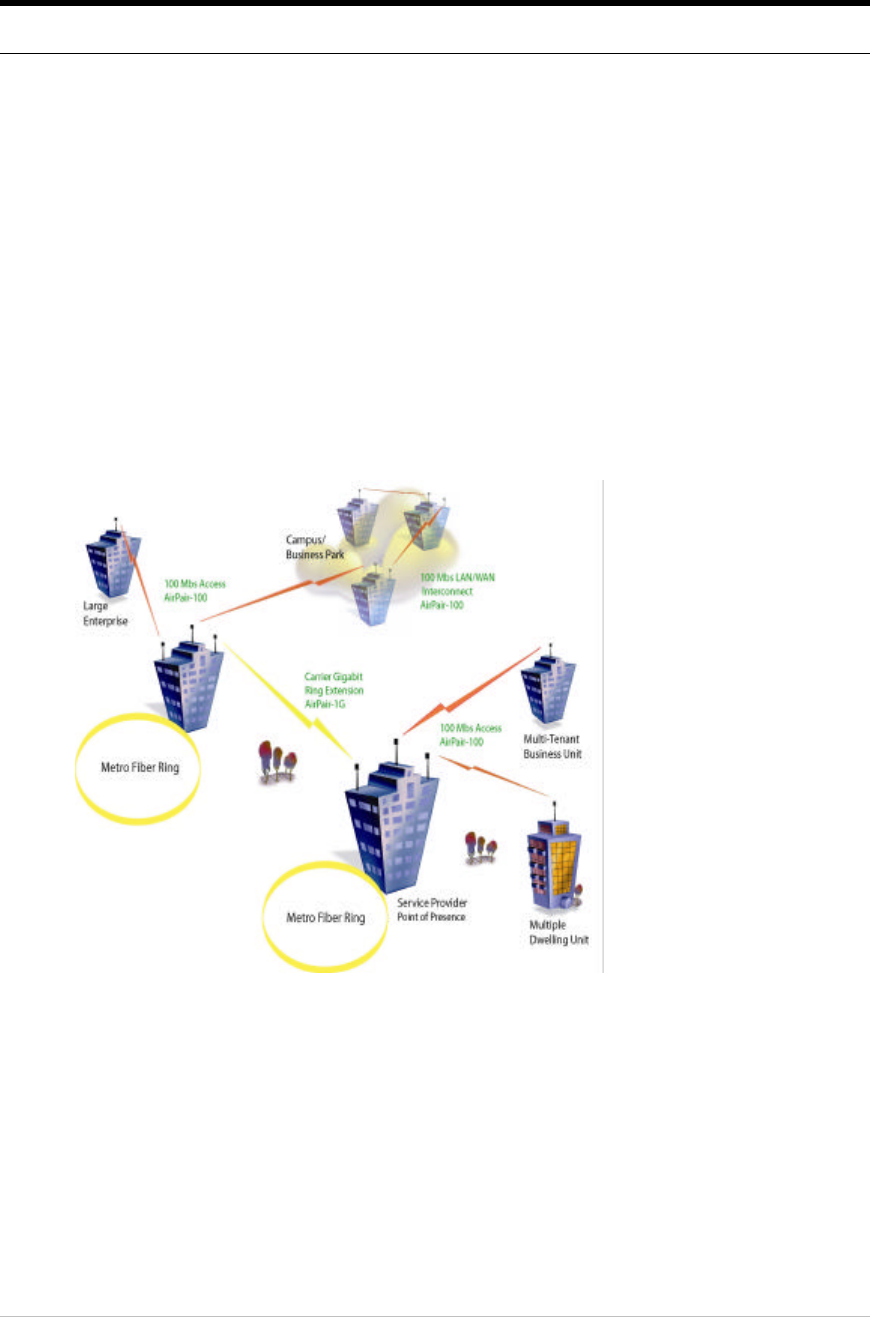
4. Description
DragonWave’s AirPair product family provides system integrators with a point-to-
point broadband radio that delivers wireless Ethernet IP-based services.
Requiring no server room installation, the all-outdoor ready AirPair installs quickly
and delivers the lowest cost per Mbit/s wireless solution in the industry. AirPair is
the ideal choice wherever rapid deployment of Carrier-grade Ethernet service is
required.
The DragonWave AirPair 100-UL is an unlicensed, wireless Ethernet bridge. The
100-UL avoids the uncertainity of service with the congested 2.4 GHz ISM and
5.8 GHz U-NII bands. Due to its narrow beam widths and the natural propagation
of 24 GHz radio waves, AirPair 100-UL is able to operate virtually interference-
free without a license up to 5 kms.
Figure 4-1 illustrates the capabilities of the DragonWave AirPair system.
Figure 4-1
AirPair System

DragonWave Inc. 12
AirPair 100 UL 24 GHz Product Manual
4.1. AirPair 100-UL Specifications
The AirPair 100-UL specifications are:
• Network Ready
o Wirespeed 100 Mbps full duplex
o SNMP-, HTTP-based network management
• Carrier Grade
o As high as 99.999% availability to meet or exceed wireline
standards
o Secure encryption standard
o Designed for rugged outdoor use
o 24 GHz Unlicensed Band
o Compliant with FCC Standards
• Cost Effective
o Engineered for rapid installation with no indoor space
requirements
o No cable trenching required
• Target Applications
o Inter-building LAN extension
o Wireless ISP backhaul
o Fiber Path Redundancy
o Homeland Security
o Disaster Recover
• Packaging
o Pole, tower or rooftop mast mounts
o Antennas offered in 12” to 48” formats
o Horizontal or vertical mounting
o Intended for outdoor use with wide range environmental
specifications
4.2. Calculating the Link Budget
To ensure that the point-to-point radio system works properly, with the expected
availability and performance, you need to perform some path loss calculations
and prepare a link budget. A link budget is an accounting of all the gains and
losses in the “over air” part of the system and allows the planner to establish the
locations and separations of each terminal in the link.

Description
13
Version 1.0
i Note
You may wish to use the AirPal Link Budget tool provided on the
AirPair Toolkit CD ROM or the Link Budget Tool included with the
PDA software.
4.2.1. Power Output
The Output Power (Pout) and the Effective Isotropic Radiated Power (EIRP) are
located on the Transmit path. The Pout is at the radio flange. The radio flange
connects to the antenna waveguide. EIRP is at the antenna output.
Table 4-1 shows output power (Pout) in both dBm and mw for the UL AirPair 50
and AirPair 100 radios.
Table 4-1
Power Output
12” Antenna 24” Antenna 36” Antenna
Power output from
radio 8 dBm 6 dBm 4 dBm
Antenna Gain 36.5 dBi 41.5 dBi 44.5 dBi
EIRP 44.5 dBm 47.5 dBm 48.5 dBm
4.3. Command Line Interface
A Command Line Interface (CLI) is available through the modem serial port. The
CLI is accessed through a terminal emulation package such as HyperTerminal®.
The user may also use an intuitive Graphic Unit Interface (GUI).
4.3.1. Configuring the Serial Port using the CLI
This section describes how to connect the AirPair to a PC using a straight-
through DB9 serial cable.
Procedure 4-1
Configuring the Serial Port using the CLI
Follow the steps below to access the AirPair CLI using a terminal emulation
program such as HyperTerminal. ®
1. Connect the serial cable from the DB9 serial port on a PC to the Serial port
on AirPair UL-100. The DB9 connector on AirPair is female; the cable from
the PC is male. A straight-through cable is required.
2. Start HyperTerminal or another terminal emulation program.
3. Set the terminal emulation program to emulate a VT100 terminal with the
following settings:

DragonWave Inc. 14
AirPair 100 UL 24 GHz Product Manual
Parameter Value
Bits per second 19200
Data bits 8
Parity none
Stop bits 1
Flow control none
4. Press <Enter>.
The AirPairTM UL-100 Login menu is displayed.

Description
15
Version 1.0
4.3.2. Create Login Account
Before you may use the AirPair system, you need to activate the Administrator
and Network Operations Center (NOC) accounts. The system is shipped with
default settings for each account, but until you change the username and the
password, these accounts are not activated.
i
Information
For security reasons, no prompt is displayed until a user account has
been established. The default accounts do not permit use of CLI
commands – they can only be used to create new user accounts.
Default Administrator Account username =oam&p
Default Administrator Account password = setup
Default NOC Account username = d&wave
Default NOC Account password= worthit
Default usernames and passwords are case sensitive.
Once the accounts have been activated, the default account
settings cannot be used again.
An Administrator Network account must be created to use the CLI commands.
The default safety account is used to create new user accounts. Only one user
account can be active at a time. Creating a new administrator user account
deletes the previous administrator user account.

DragonWave Inc. 16
AirPair 100 UL 24 GHz Product Manual
Procedure 4-2
Create Login Account
Use this procedure to create a new administrator user account.
Required Action Steps
Create Login Account Notes:
• As a security measure prior to setup of initial account, no user
prompt appears.
• The default account can only set up a user account. No other
commands will work.
• Only one account can be setup. Each new account setup
overwrites the older account.
Sequence to activate the Administrator account:
Log in for the first time using the default safety account:
press Enter to get the modem
Enter the oam&p username:
username: oam&p press Enter
Enter the default password:
password: setup press Enter
Create a new Administrator account:
press Enter to get the modem
Enter your username (Maximum of 10 characters):
username: <username> press Enter
Confirm you username:
username: <username> press Enter
Enter your password (Maximum of 10 characters):
password: <password> press Enter
Enter your password again
password: <password> press Enter
Log out:
lo press Enter
Log in using the new account.
Press Enter to get the modem

Description
17
Version 1.0
Required Action Steps
Enter your username:
username: <username> press Enter
Enter your password:
password: <password> press Enter
Change NOC username and
password Changes the NOC username and password for security reasons. The
default NOC username is d&wave. The default NOC password is
worthit.
Sequence:
Enter the NOC Safety User username:
username: d&wave press Enter
Enter the NOC Safety User password:
password: worthit press Enter
Enter the new NOC username (Maximum of 10 characters):
username: <username> press Enter
Confirm the username:
username: <username> press Enter
Enter the new NOC password (Maximum of 10 characters):
password: <password> press Enter
Enter the password again
password: <password> press Enter
Lo Logs out of the system.
Sequence:
lo press Enter
The system responds:
goodbye

DragonWave Inc. 18
AirPair 100 UL 24 GHz Product Manual
4.4. Set AirPair Frequency
This section describes how to set the radio frequency and transmit power using
the CLI. Before setting the frequency or transmitting power, ensure that the radio
is connected to the modem through a serial port.
Note: One must be GO and the other must be Return. Vertical and horizontal
polarizations are completed during install.
Procedure 4-3
Set AirPair Frequency available and Transmit Power
Follow this procedure to set the 24 GHz AirPair frequency channels for pre-
defined frequency pairs (coupled frequencies) and to set the gain.
Note: To perform this procedure, you must have NOC user rights.
Required Action Steps
login as an NOC user Logs in as an NOC user.
Sequence:
Enter an NOC username:
Username <username> press Enter
Enter an NOC password:
Password: <password> press Enter
get radio band Displays the type (band) of radio that the user expects to connect to the
modem.
Sequence:
get radio band press Enter
The system responds:
Currently selected Radio Band: [none/un24].
Radio bands available in the system:
none fcc18a fcc18b fcc18c ic18a ic18b
ic18c fcc23a fcc23b fcc23c fcc23d ic23a
ic23b fcc28a fcc28b china23 un24
set radio band [none /
un24] Sets the band of radio to which the user expects to connect the modem.
Sequence:
set radio band [band] press Enter
where
band is none / un24
The system responds:
Radio band Selected [none/un24].

Description
19
Version 1.0
Required Action Steps
get frequency bank Displays the frequency bank.
Sequence:
get frequency bank press Enter
The system responds:
un24
go FREQUENCIES(Selected)
Index TX IF RX IF TX RF RX RF
UNL1 670 2000 24080 24150
UNL2 660 1990 24090 24160
UNL3 650 1980 24100 24170
UNL4 640 1970 24110 24180
UNL5 630 1960 24120 24190
UNL6 620 1950 24130 24200
UNL7 610 1940 24140 24210
UNL8 600 1930 24150 24220
return FREQUENCIES
Index TX IF RX IF TX RF RX RF
UNL'1 600 2070 24150 24080
UNL'2 590 1990 24160 24090
UNL'3 580 2050 24170 24100
UNL'4 570 2040 24180 24110
UNL'5 560 2030 24190 24120
UNL'6 550 2020 24200 24130
UNL'7 540 2010 24210 24140
UNL'8 530 2000 24220 24150
Note: All Frequencies in MHz.
set frequency bank Sets the frequency bank to coupled (paired) or decoupled (unpaired or
CUSTOM) frequencies.
Sequence:
set frequency bank [go/return] press Enter
The system responds:
Frequency Bank selected: [go/return]

DragonWave Inc. 20
AirPair 100 UL 24 GHz Product Manual
Required Action Steps
get available frequency Displays the frequency bank. This will show the frequencies for the
direction programmed using the set frequency bank command. If the
frequency bank was selected to GO, then the GO bank of frequencies is
displayed, and similarly the RETURN bank of frequencies is displayed if
the RETURN frequency bank was selected. .
Sequence:
get available frequency press Enter
The system responds:
(“go” frequencies shown. “return” frequencies will be displayed if the
return bank was programmed).
go Frequencies
Index TX IF RX IF TX RF RX RF
UNL1 670 2000 24080 24150
UNL2 660 1990 24090 24160
UNL3 650 1980 24100 24170
UNL4 640 1970 24110 24180
UNL5 630 1960 24120 24190
UNL6 620 1950 24130 24200
UNL7 610 1940 24140 24210
UNL8 600 1930 24150 24220
Note: All Frequencies in MHz.
set programmed frequency
[frequency index] Sets the programmed frequency.
Sequence:
set programmed frequency [frequency index] press Enter
The system responds: ( example uses set programmed frequency
UNL1)
Index TX IF RX IF TX RF RX RF
UNL1 670 2000 24080 2415
Note: All Frequencies in MHz.
get programmed frequency Displays the programmed frequency.
Sequence:
get programmed frequency press Enter
The system responds: ( example uses set programmed frequency
UNL1)
Index TX IF RX IF TX RF RX RF
UNL1 670 2000 24080 24150
Note: All Frequencies in MHz.

Description
21
Version 1.0
Required Action Steps
get antenna diameter Displays the programmed antenna diameter.
Sequence:
get antenna diameter press Enter
The system responds:
Antenna Diameter:
12 inch
24 inch
36 inch - Programmed
Note: The antenna diameter affects the radio Tx power for radio band
un24 only.
Set antenna diameter
[index] Displays the programmed antenna size.
Sequence:
Set antenna diameter [index] press Enter
where
index is 1,2,3
The system responds:
Programmed Antenna Diameter: [12 inch /24 inch /36 inch]
Note: The antenna diameter affects the radio Tx power for radio band
un24 only.

DragonWave Inc. 22
AirPair 100 UL 24 GHz Product Manual
Required Action Steps
set transmit power [power
in dBm] Sets the transmit power, if required.
Sequence:
set transmit power [power in dBm] press Enter
where
[power in dBm] is a multiple of 10 value, i.e. 132 represents 13.2
dBm, 94 represents 9.4 dBm.
The system responds:
System is programmed and transmitting at [powerLevel] dBm.
If the radio is not connected, the system responds:
System programmed to [powerLevel] dBm. Radio communication
has failed. System not transmitting.
If the radio transmit calibration table is not programmed into the
radio, the system responds:
System programmed to [powerLevel] dBm.
Note: Radio requires calibration tables in order to set the transmit power
level. [powerLevel] dBm will NOT be used.
reset system Resets the system to save the settings to FLASH and restart the system
with the new settings taking effect. If you do not want to restart the
system, use the command save MIB to save the settings to FLASH.
Sequence:
reset system press Enter
The system responds:
system reset

Description
23
Version 1.0
4.5. Set AirPair Custom Frequency Settings
This section details how to set the frequency channels for user-defined custom
frequency pairs, i.e., decoupled frequencies, and how to set the gain.
Procedure 4-4
Setting the 24GHz AirPair Frequency channels for user-defined custom
frequency pairs
Perform this procedure to set the 24 GHz AirPair frequency channels for user-
defined custom frequency pairs (decoupled frequencies) and to set the gain.
Notes:
1. The system must first be programmed with coupled frequencies (pre-
defined frequency pairs) before it may be changed to CUSTOM
frequency.
2. It is recommended you use the pre-defined coupled frequency pairs
for 24 GHz. The custom frequency combinations are available to
address potential future interference issues.
3. To perform this procedure, you must have NOC user rights.
Required Action Steps
login as a NOC user Logs in as an NOC user.
Sequence:
Enter an NOC username:
username: <username> press Enter
Enter an NOC password:
password: <password> press Enter
get radio band Displays the type (band) of radio that the user expects to connect to the
modem.
Sequence:
get radio band press Enter
The system responds:
Selected Radio Band: [None/un24]
set radio band
[ None/ un24]
Sets the band of radio to which the user expects to connect the modem.
Sequence:
set radio band UNL24 press Enter
The system responds:
Radio Band Selected: [None/ un24]

DragonWave Inc. 24
AirPair 100 UL 24 GHz Product Manual
Required Action Steps
get programmed frequency Displays the programmed frequency.
Sequence:
Get programmed frequency press Enter
The system responds: ( example uses programmed frequency UNL1)
Index TX IF RX IF TX RF RX RF
UNL1 670 2000 24080 24150
Note: All Frequencies in MHz.
get unlicensed frequencies
Rx Displays the bank of CUSTOM receive (Rx) frequencies available for
use.
Sequence:
get unlicensed frequencies rx press Enter
The system responds: (example uses rx frequencies)
Index RX IF RX RF
CUSTOM1 2070 24080
CUSTOM2 2060 24090
CUSTOM3 2050 24100
CUSTOM4 2040 24110
CUSTOM5 2030 24120
CUSTOM6 2020 24130
CUSTOM7 2010 24140
CUSTOM8 2000 24150
CUSTOM9 1990 24160
CUSTOM10 1980 24170
CUSTOM11 1970 24180
CUSTOM12 1960 24190
CUSTOM13 1950 24200
CUSTOM14 1940 24210
CUSTOM15 1930 24220
Note: All Frequencies in MHz.

Description
25
Version 1.0
Required Action Steps
set unlicensed frequencies
rx [index]
Sets the frequency to CUSTOM (decoupled) frequencies for receive (Rx)
direction.
Note: the transmit (Tx) and receive (Rx) frequencies must differ by
at least 70 MHz.
Sequence:
set unlicensed frequencies Rx [index] press Enter
where
Rx is the receive direction.
Index is the index number of the frequency.
The system responds: (example uses custom unlicensed
frequencies)
Index TX IF RX IF TX RF RX RF
CUSTOM 670 1980 24080 24170
Note: All Frequencies in MHz.
get unlicensed frequencies
Tx
Displays the bank of CUSTOM transmit (Tx) frequencies available for
use.
Sequence:
get unlicensed frequencies Tx press Enter
The system responds: (example uses Tx frequencies)
Index TX IF TX RF
CUSTOM1 670 24080
CUSTOM2 660 24090
CUSTOM3 650 24100
CUSTOM4 640 24110
CUSTOM5 630 24120
CUSTOM6 620 24130
CUSTOM7 610 24140
CUSTOM8 600 24150
CUSTOM9 590 24160
CUSTOM10 580 24170
CUSTOM11 570 24180
CUSTOM12 560 24190
CUSTOM13 550 24200
CUSTOM14 540 24210
CUSTOM15 530 24220
Note: All Frequencies in MHz.

DragonWave Inc. 26
AirPair 100 UL 24 GHz Product Manual
Required Action Steps
set unlicensed frequencies
Tx [index] Sets the frequency to CUSTOM (decoupled) frequencies for the transmit
(tx) direction
Note: the transmit (Tx) and receive (Rx) frequencies must differ by
at least 70 MHz.
Sequence:
set unlicensed frequencies Tx [index] press Enter
where
Tx is the transmit direction.
Index is the index number of the frequency.
The system responds: (example uses custom unlicensed
frequencies)
Index TX IF RX IF TX RF RX RF
CUSTOM 660 1980 24090 24170
Note: All Frequencies in MHz.
get programmed frequency Displays the programmed frequency:
Sequence:
get programmed frequency press Enter
The system responds: ( example uses custom programmed
frequencies)
Index TX IF RX IF TX RF RX RF
CUSTOM 670 2000 24080 24150
Note: All Frequencies in MHz.
get programmed frequency Displays the programmed frequency:
Sequence:
get programmed frequency press Enter
The system responds: ( example uses custom programmed
frequencies)
Index TX IF RX IF TX RF RX RF
CUSTOM 670 2000 24080 24150
Note: All Frequencies in MHz.

Description
27
Version 1.0
Required Action Steps
get antenna diameter Displays the programmed antenna diameter.
Sequence:
get antenna diameter press Enter
The system responds:
Antenna Diameter:
12 inch
24 inch
36 inch - Programmed
Note: The antenna diameter affects Tx power for radio band un24
only.
Set antenna diameter
[index] Sets the programmed antenna size.
Sequence:
Set antenna diameter [index] press Enter
where
index is 1,2,3
The system responds:
Programmed Antenna Diameter: [12 inch /24 inch /36 inch]
Note: The antenna diameter affects Tx power for radio band un24
only.

DragonWave Inc. 28
AirPair 100 UL 24 GHz Product Manual
Required Action Steps
set transmit power [power
in dBm] Sets the transmit power, if required.
Sequence:
set transmit power [power in dBm] press Enter
where
[power in dBm] is a multiple of 10 value, i.e., 132 represents 13.2
dBm, 94 represents 9.4 dBm.
The system responds:
System is programmed and transmitting at [powerLevel] dBm.
If the radio is not connected, the system responds:
System programmed to [powerLevel] dBm. Radio communication
has failed. System not transmitting.
If the radio transmit calibration table is not programmed into the
radio, the system responds:
System programmed to [powerLevel] dBm.
Note: Radio requires calibration tables in order to set the transmit
power level. [powerLevel] dBm will NOT be used.
reset system Resets the system to save the settings to FLASH and restart the system
with the new settings taking effect. If you do not want to restart the
system, use the command save MIB to save the settings to FLASH.
Sequence:
reset system press Enter
The system responds:
system reset.

Description
29
Version 1.0
4.6. Set IP address
You can use Telnet to access the AirPair system from your PC using an Internet
Protocol (IP) address. An IP address is a number given to a device so that a
network can identify it. The IP address format is a 32-bit numeric address written
as four numbers separated by periods. For example, 192.168.0.1 could be an IP
address. If you assign an IP address to your radio, you can access the radio from
your network.

DragonWave Inc. 30
AirPair 100 UL 24 GHz Product Manual
Procedure 4-5
Setting the IP Address
Perform this procedure to set the IP address for the system so you can access
the AirPair from your desktop.
Required Action Steps
Login Log in as a NOC user. Only the NOC user is allowed to set the IP
address.
Sequence:
Enter an NOC username:
username: <username> press Enter
Enter an NOC password:
password: <password> press Enter
set ip address Set the IP address used for the system.
Sequence:
set ip address [123.123.123.123] press Enter
where
[123.123.123.123] is in decimal dot notation.
The system responds:
System IP address: [123.123.123.123]]
set subnet mask
Sets the subnet mask used for the system.
Sequence:
set subnet mask [123.123.123.123] press Enter
where
[123.123.123.123] is in decimal dot notation.
The system responds:
System subnet mask:[123.123.123.123]
set default gateway Sets the default gateway parameter for the system. The default router
must be an IP address specified in decimal-dot notation, e.g.,
192.168.0.1.
Sequence:
set default gateway [123.123.123.123] press Enter
where
[123.123.123.123] is in decimal dot notation.

Description
31
Version 1.0
Required Action Steps
The system responds:
NAK’
if request cannot be processed, otherwise returns the following which
acknowledges completion of the request:
System default gateway: 123.123.123.123
reset system Resets the system to save the setting to FLASH and restart the system
with the new settings taking effect.
Sequence:
reset system press Enter
The system responds:
system reset.

DragonWave Inc. 32
AirPair 100 UL 24 GHz Product Manual
4.7. VLAN tagging
A Local Area Network (LAN) is a single-broadcast domain. If a user broadcasts
information on the LAN, every other user on the LAN receives the broadcast. A
router prevents broadcast messages from leaving a LAN, which reduces
collisions and improves performance.
A network manager can create smaller broadcast domains and reduce network
broadcasts by logically segmenting a LAN into different broadcast domains.
These broadcast domains are called Virtual Local Area Networks (VLANs).
Workstations on a VLAN do not have to be located together because they are
segmented logically, not physically.
VLANs offer a number of advantages over traditional LANs including:
• Performance
• Security
• formation of virtual workgroups
• cost reduction
All ports on a switch are configured for a default VLAN (usually VLAN1). When a
switch receives data from a workstation, it tags the data with a VLAN identifier
indicating the originating VLAN. The switch sends the data to the ports inside the
VLAN where it originated. It also sends the data to a trunking port if one is
available.
Network Administrators create VLAN groups and place backbone network
devices into the VLAN group to simplify administration and increase security of
the devices. VLAN tagging allows network administrators to add AirPair nodes to
the administrative network. VLAN tagging restricts administrative access to
devices that are members of the VLAN group.
If you program an AirPair node with an IP address but do not enable VLAN
tagging, the node responds to Ping, Telnet and SNMP commands from any
device on the network. Telnet and SNMP require a username and password, the
proper IP address and community string, respectively.
If you enable VLAN tagging, the AirPair nodes respond to ping commands but do
not respond to Telnet and SNMP commands unless the packet has the correct
VLAN tag. The Telnet and SNMP requests must have the correct VLAN tag and
come from a device within the VLAN domain.
The Institute of Electrical and Electronic Engineers (IEEE) is working on a draft
standard 802.1Q for VLANs. Currently, most products are proprietary and
anyone wanting to install VLANs has to purchase all products from the same
vendor. DragonWave implements AirPair VLAN Tagging using the 802.1Q
standard. For more information on the Standard, see the web page:
http://grouper.ieee.org/groups/802/1/pages/802.1Q.html

Description
33
Version 1.0
Procedure 4-6
Setting VLAN Tag
i
Note
If you set the VLAN tag to the incorrect value, you can lose
remote access to the AirPair. Make sure the VLAN tag matches
your administrative network tag.
Perform this procedure to enable VLAN tagging for the AirPair.
Note: To perform this procedure, you must have NOC user rights.
Required Action Steps
login Log in as an NOC user.
Sequence:
Enter an NOC username:
username: <username> press Enter
Enter an NOC password:
password: <password> press Enter
get vlan tagging Displays the VLAN tagging operational state for the system.
Sequence:
get vlan tagging press Enter
The system responds:
VLAN tagging is [off | on]
set vlan tagging [on/off] Sets VLAN tagging on for the system.
Sequence:
set vlan tagging on press Enter
The system responds:
VLAN tagging is on.
set vlan tag [8100XXXX] Enables or disables VLAN tagging for the system. VLAN tagging is
enabled when you enter the hex characters 8100 immediately followed
by the 2-byte tag control information field. Note: If you set the VLAN
tag to the incorrect value, you can lose remote access to the
AirPair. Make sure the VLAN tag matches your administrative
network tag.
Sequence:

DragonWave Inc. 34
AirPair 100 UL 24 GHz Product Manual
Required Action Steps
set vlan tag [8100XXXX] press Enter
where
XXXX is the two byte tag control
The system responds:
VLAN tagging is [off | on using 8100XXXX]
get vlan tag Displays that the VLAN tagging information for the system is correct. If
you have entered an incorrect VLAN tag, you cannot communicate
remotely with the AirPair.
Sequence:
get vlan tag press Enter
The system responds:
VLAN tagging is [off | on using tag 8100XXXX]
Reset system Resets the system to save the settings to FLASH and restart the
system with the new settings taking effect. If you do not want to restart
the system, use the command save MIB to save the settings to
FLASH.
Sequence:
reset system press Enter
The system responds:
system reset.
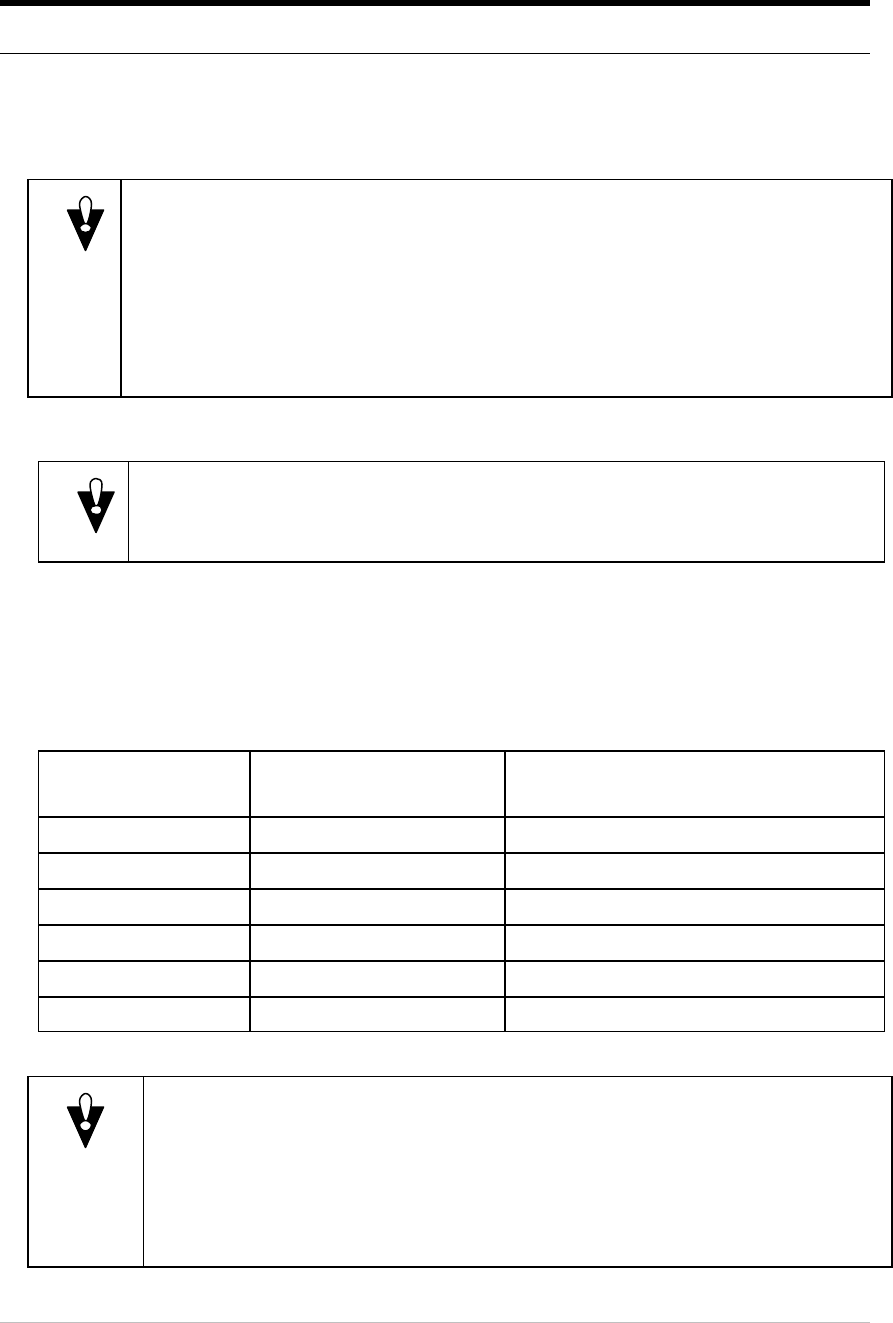
5. Installation
This section describes how to install the DragonWave AirPair. Perform the
procedures in this section in sequence presented.
5.1. Before you begin
Caution
DragonWave Inc. recommends to connect the AirPair system to
an Uninterruptable Power Supply (UPS) or an equivalent system
in order to withstand power interruptions.
Before installation, preset each DragonWave radio to the desired
channel within the frequency band allocated to this particular
installation.
5.2. Mounting Specifications
Caution
The mounting poles must be capable of providing sufficient
stability.
The mounting pole, tripod, mast or tower mount, must be able to provide
sufficient stability to prevent movement or vibration. You must take into account
wind loading, twist, sway and vibration. Table 5-1 shows the mounting pole
details.
Table 5-1
Mounting Pole Specifications for SKED 80 Steel Pipe
Antenna Diameter Steel Pipe Nominal
Diameter Max. Distance Above Last Rigid
Attachment Point
12” 3 “ 3 ft
12” 4” 4 ft
24” 3” 2 ½ ft
24” 4” 3 ft
36” 4” 3 ft
48” 4” 3 ft
Caution
Refer to local safety standards and building codes for
installation, grounding and lightning protection requirements
prior to planning installation.
DragonWave Inc. recommends at least one crew member at
each end of the link during the installation.

DragonWave Inc. 36
AirPair 100 UL 24 GHz Product Manual
This page is intentionally left blank.
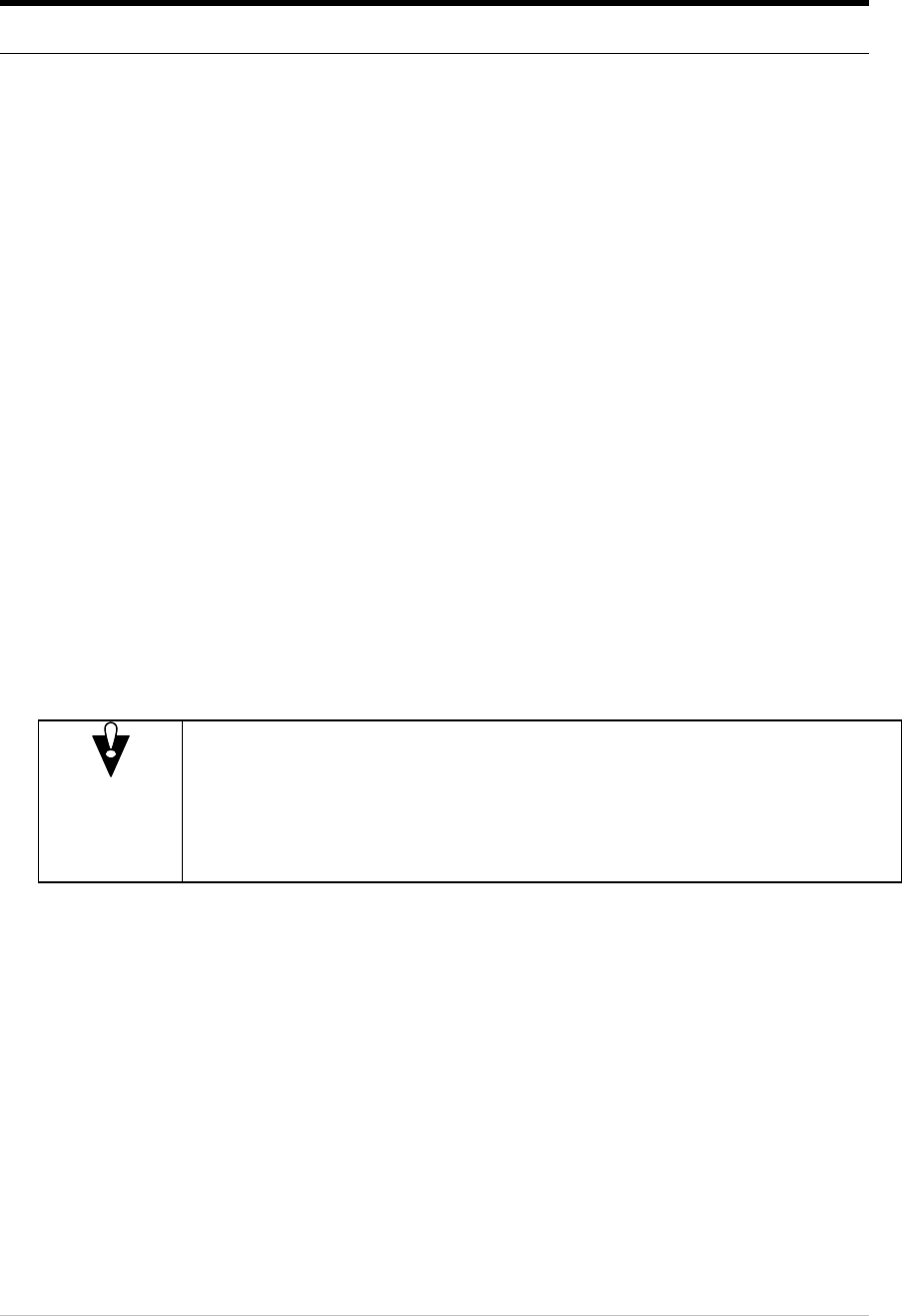
6. Installation of Radio and Modem
This section describes how to install the radio and modem. The steps in the
installation are:
• install mounting bracket onto mast or tower
• mount the radio and antenna onto the mounting bracket
• perform visual alignment of radio
• attach modem onto mounting bracket
• connect the low-loss RF cable and the RS-232 cable between the
modem and the radio
• install grounding and lightning protection
• connect power to the modem by connecting the power cable
between the power pack and the modem
• perform fine-adjust alignment of the radios using the PDA
• perform data test
• connect the LAN to the modem
6.1. Mounting the Radio and Antenna onto the Mounting
Bracket
Procedure 6-1
Mounting the 12″and 18″ antennas
Caution
The endpoints MUST be cross-polarized radios/antennas in
order for the system to properly function. One end must be
set to vertical polarization and the other end to horizontal.
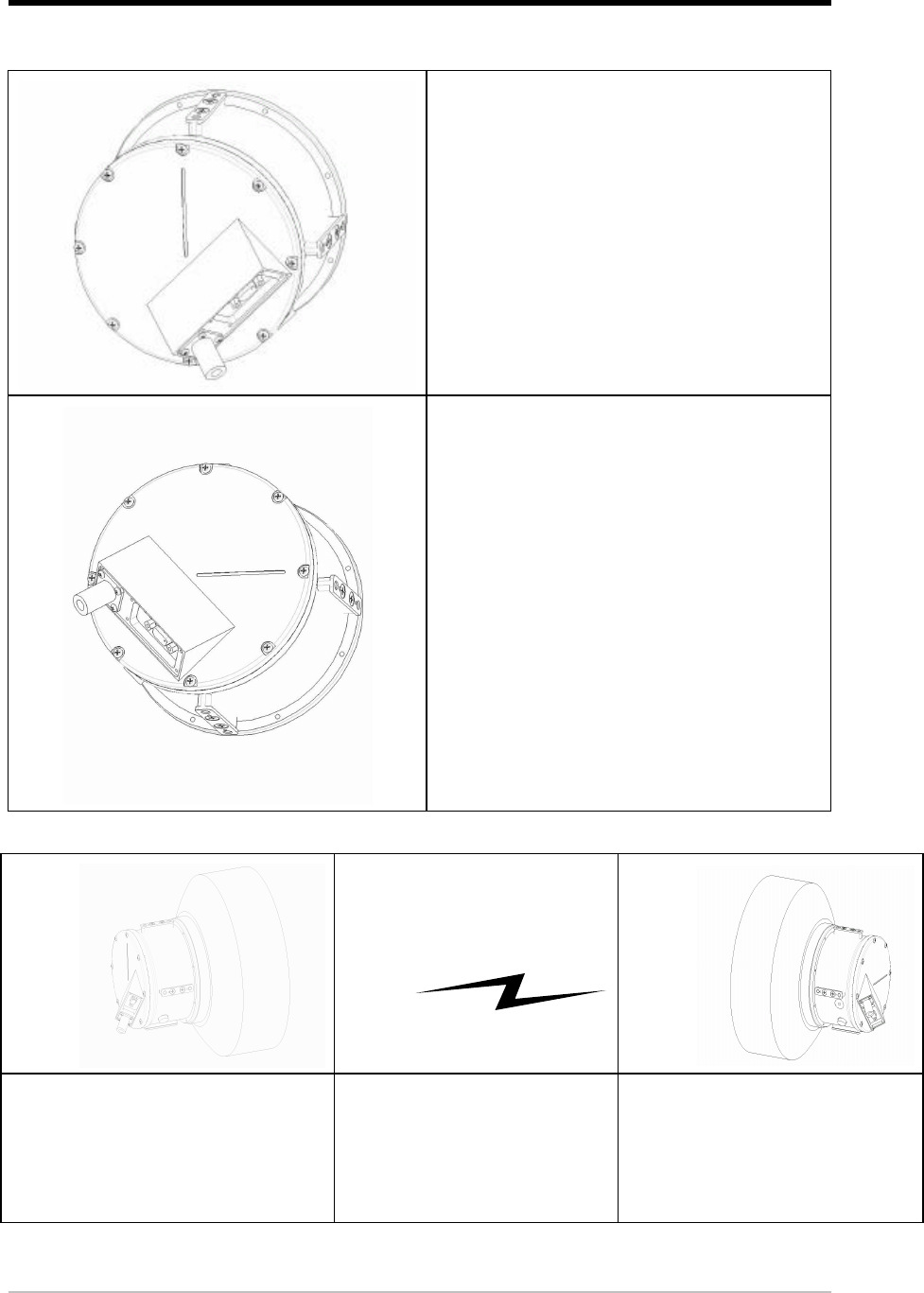
DragonWave Inc. 38
AirPair 100 UL 24 GHz Product Manual
Perform this procedure to mount the 12″ and 18″ antennas and radios.
Vertical Polarization:
Groove on back plate is in vertical
orientation.
Cables point down and to the right.
Horizontal Polarization:
Groove on back plate is in horizontal
orientation.
Cables point down and to the left.
One end MUST be
Vertical Polarization
(backplate groove is
vertical)
The other end MUST
be Horizontal
Polarization
(backplate groove is
horizontal)
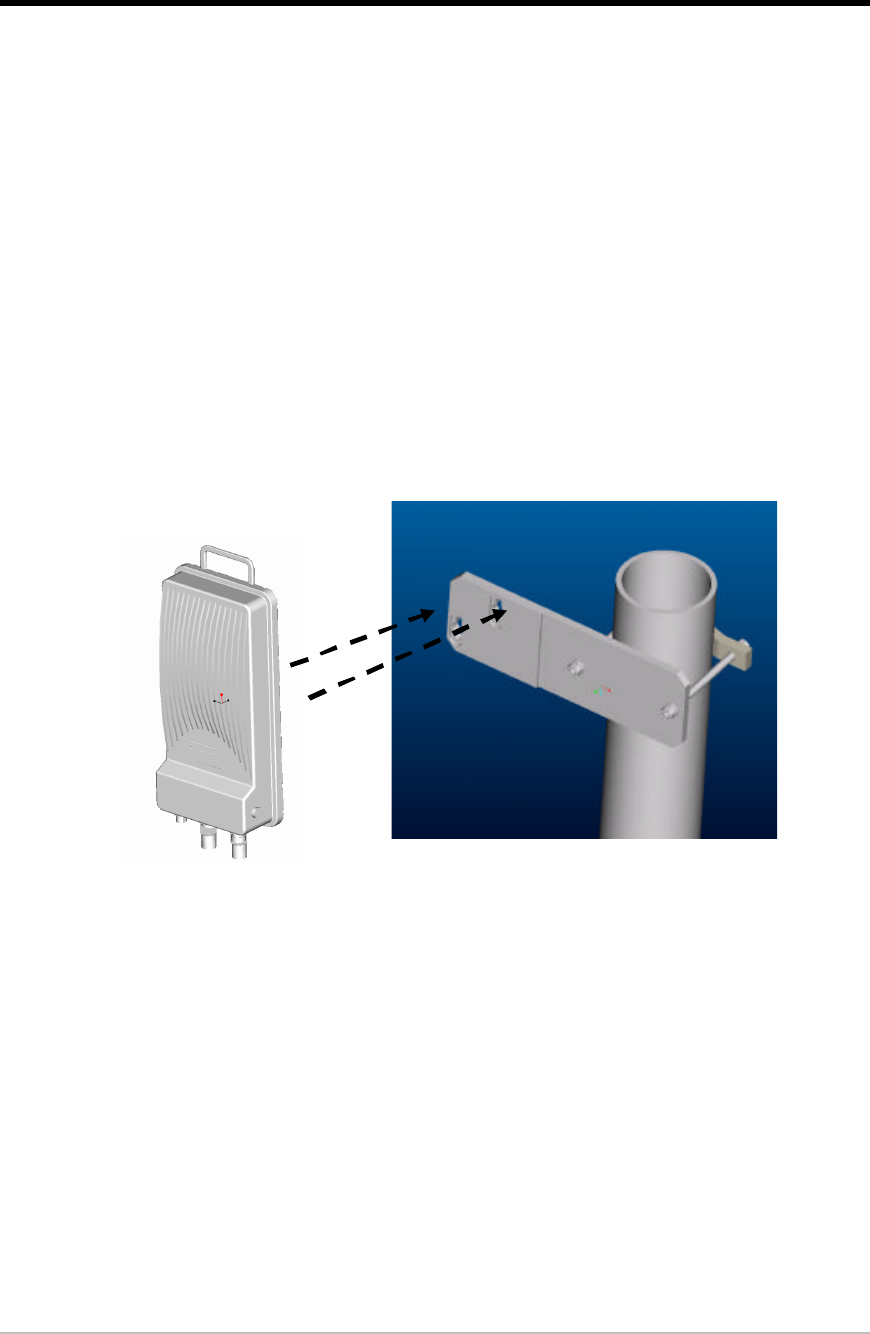
Installation of Radio and Antenna
39
Version 1.0
6.2. Visually-aligning Radios
This section describes how to visually align the radios.
Procedure 6-2
Visually align the radios
Perform this procedure to visually align the radios.
1. Visually align the radios to each other. Be as accurate as possible.
2. Visually align one end of the point-to-point link. Repeat this procedure for the
other end.
3. Place a mark on the radio bracket to identify the starting point before you
begin to fine-tune the radio alignment.
Figure 6-1
Modem on Mounting Bracket
Procedure 6-3
Attaching the Modem to Mounting Bracket
Perform this procedure to attach the modem to the mounting bracket:
1. Install the mounting bracket onto the mast.
2. Install the modem onto the bracket. Make sure the modem is mounted above
the antenna so there is sufficient cable length.
3. Ensure all hardware is tightened according to the following torque
specifications.
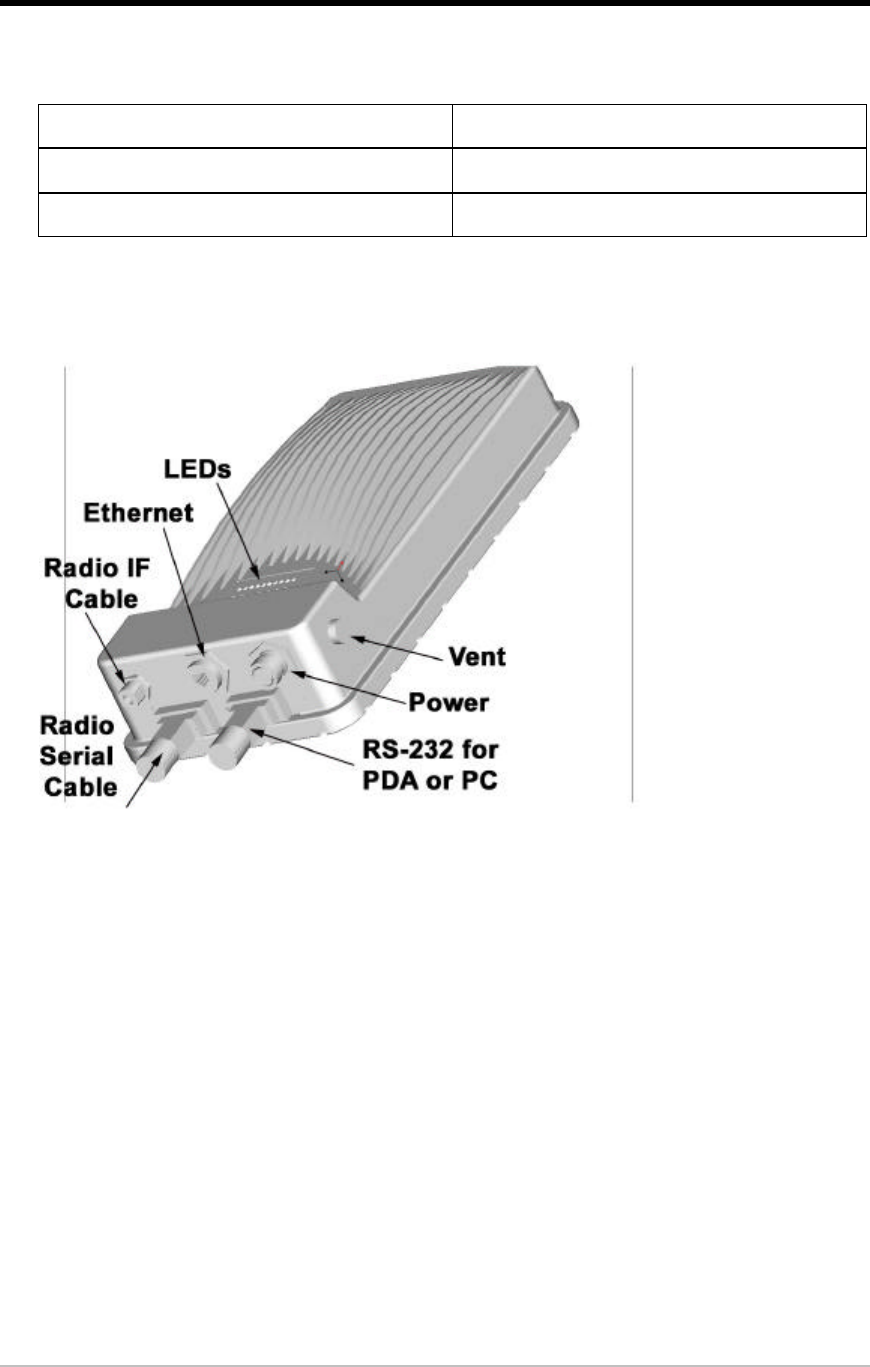
DragonWave Inc. 40
AirPair 100 UL 24 GHz Product Manual
Table 6-1
Torque Specifications for mounting modem to bracket
Bolt size in inches Nut torque
3/8 15 ft-lbs
1/4 9 ft-lbs
Figure 6-2
Modem
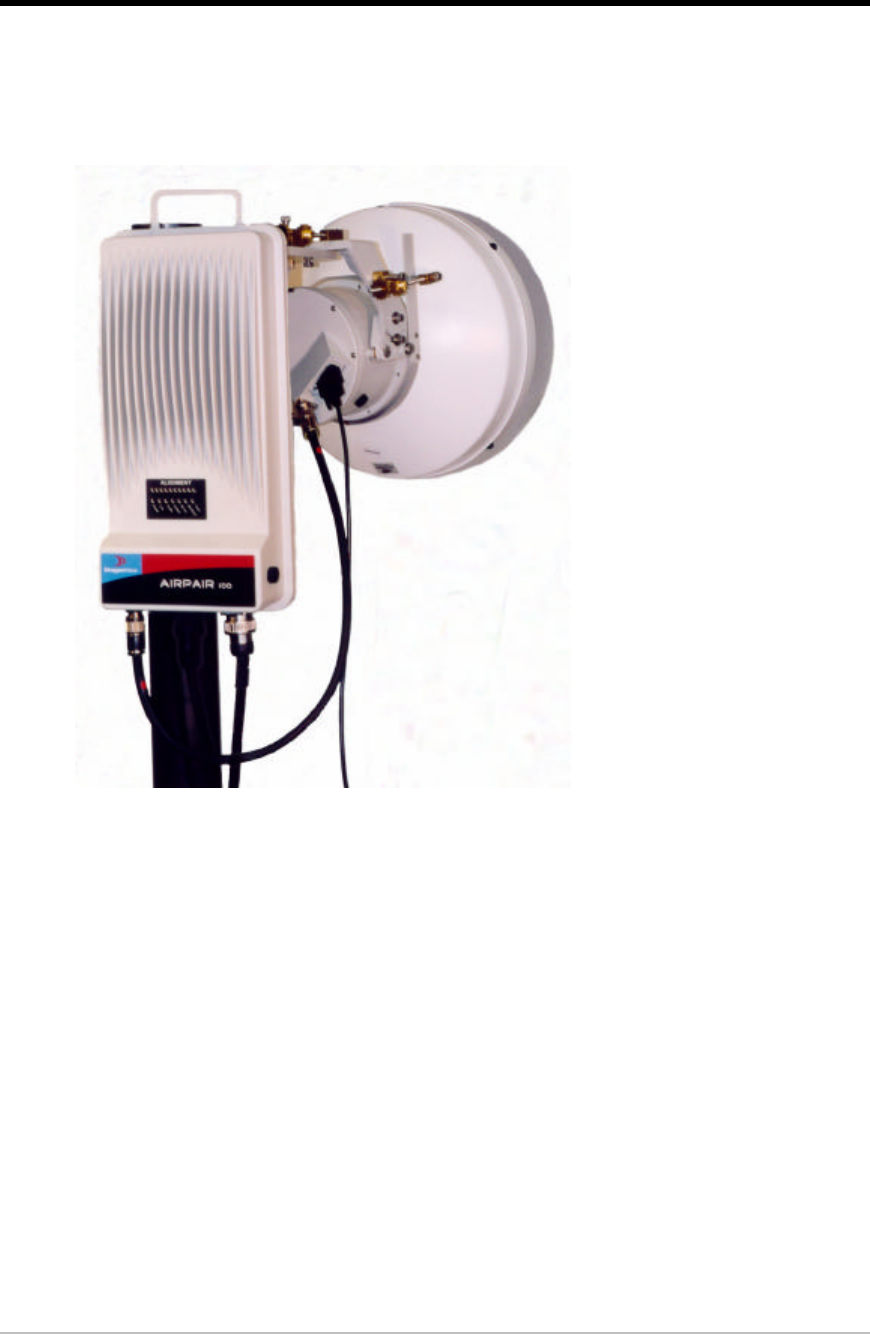
Installation of Radio and Antenna
41
Version 1.0
Figure 6-3
Modem connected to Radios and 18″, 24″ and 36″ antennas
24 GHz system with 18” dish
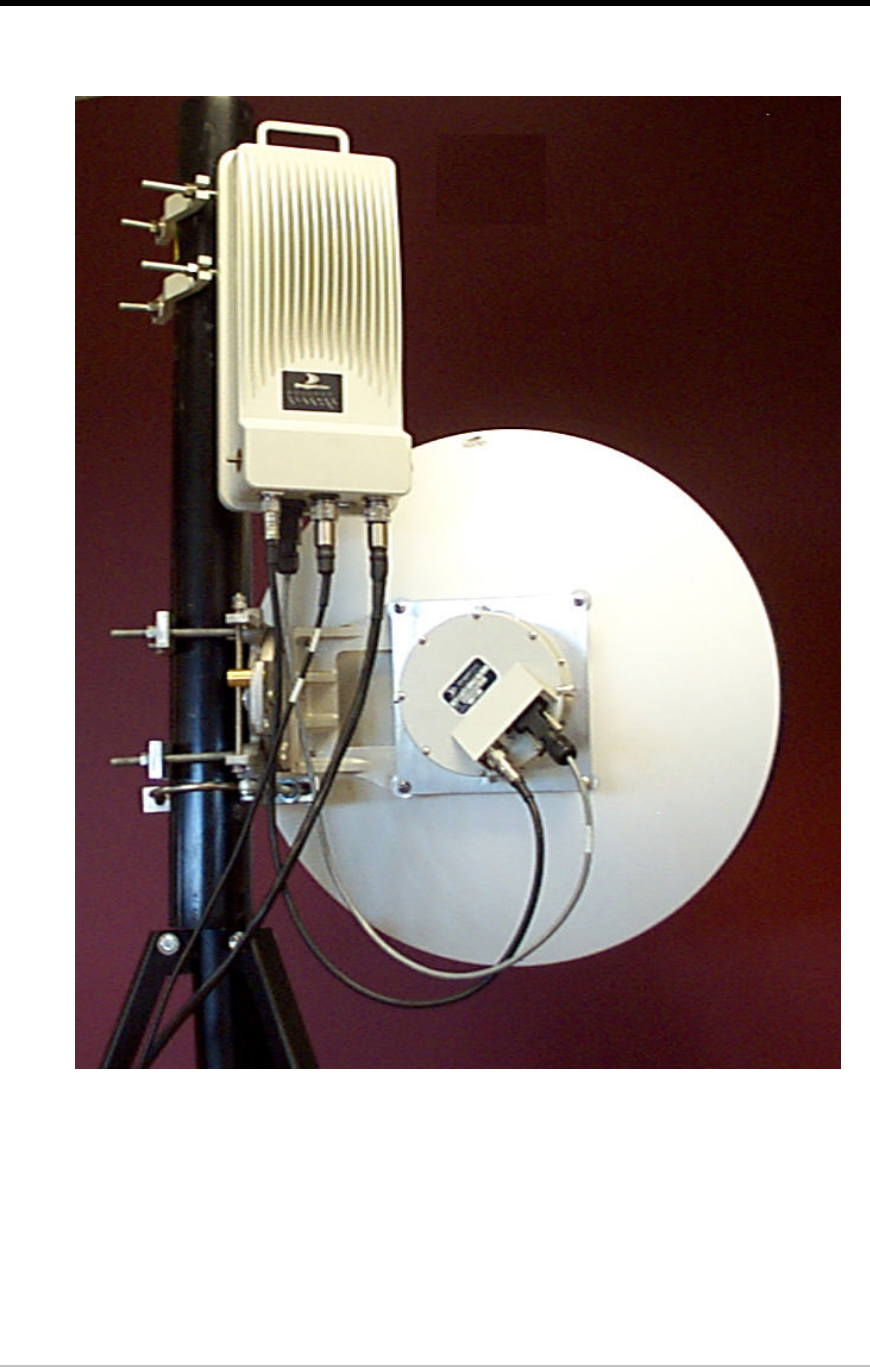
DragonWave Inc. 42
AirPair 100 UL 24 GHz Product Manual
Figure 6-4
24 GHz system with 24” antenna mounted
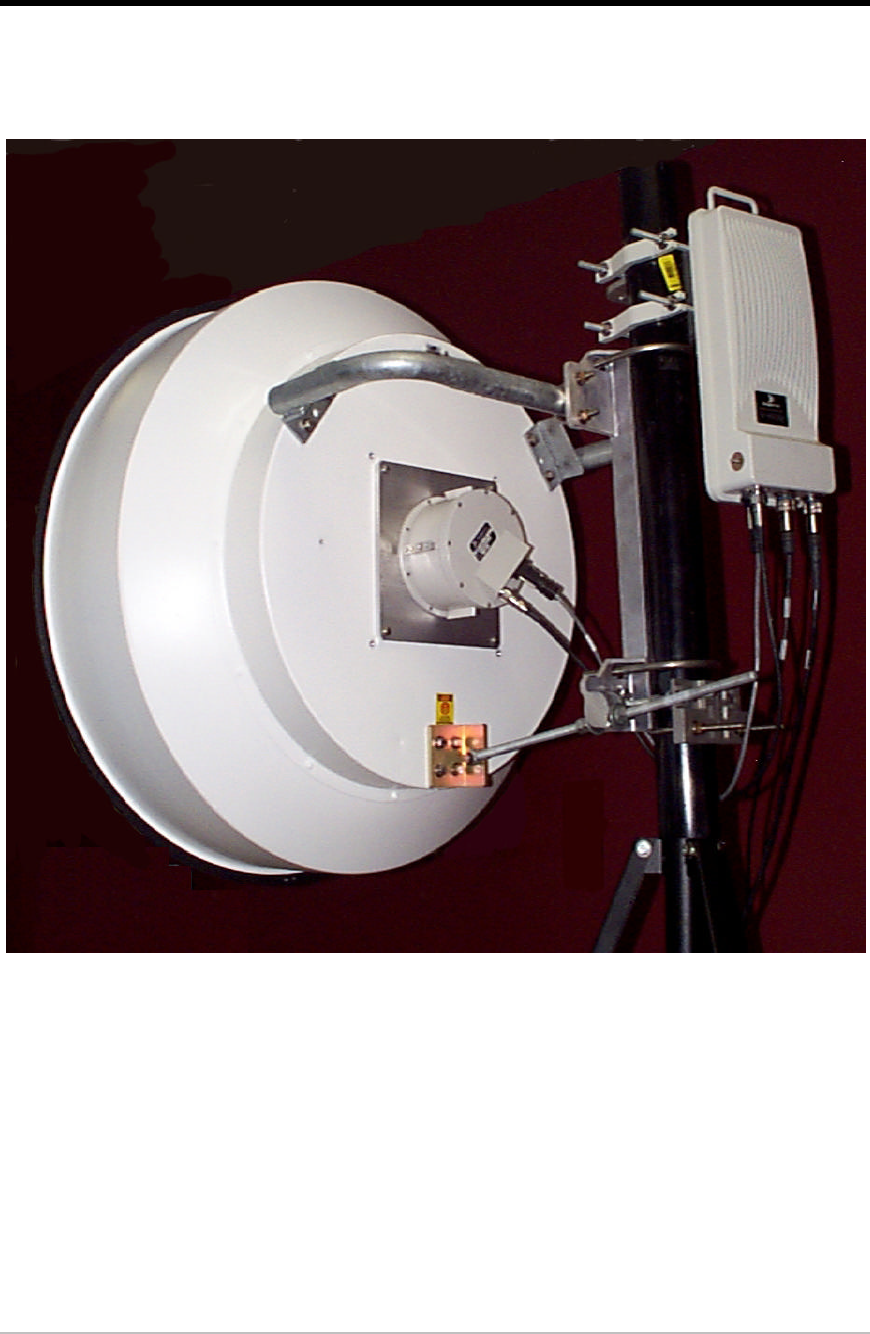
Installation of Radio and Antenna
43
Version 1.0
Figure 6-5
24 GHz system with 36” antenna mounted
Procedure 6-4
Connecting the IF and RS-232 cable to the modem and radio
Perform this procedure to connect the IF and RS-232 cable to the modem and
radio.
1. Connect IF cable to the IF connector on the modem and the radio.
2. Connect the RS-232 cable to the serial connector on the modem and the
radio.
Note: Do NOT connect the Power cable or the CAT5 Ethernet cable to LAN
equipment at this time.
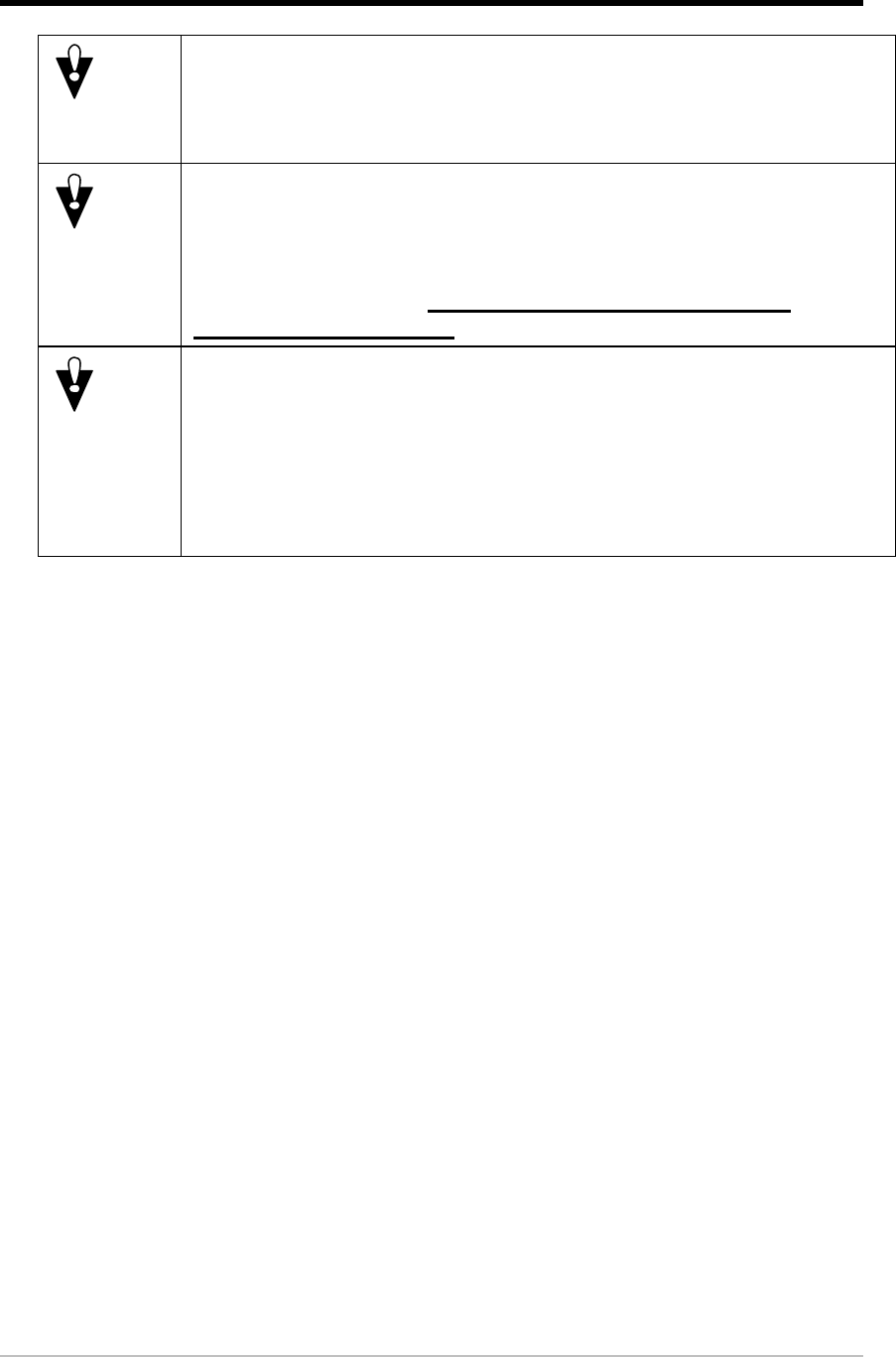
DragonWave Inc. 44
AirPair 100 UL 24 GHz Product Manual
Caution
Lightning protection is required by the DragonWave
Warranty Statement. Failure to provide proper lightning
protection can result in the Product Warranty being void.
Caution
Lightning protection regulations and standards for proper
protection are covered under the national or regional
electrical safety codes such as the National Electrical Code
in the United States. Follow your national or regional
electrical safety codes!
Caution
The outdoor components are to be grounded, and lightning
arrestors are to be connected in accordance with local,
regional and national codes. All local building and electrical
codes specified by local civil authorities must be followed.
Standard safety procedures for installing and working with
this type of equipment must also be followed.
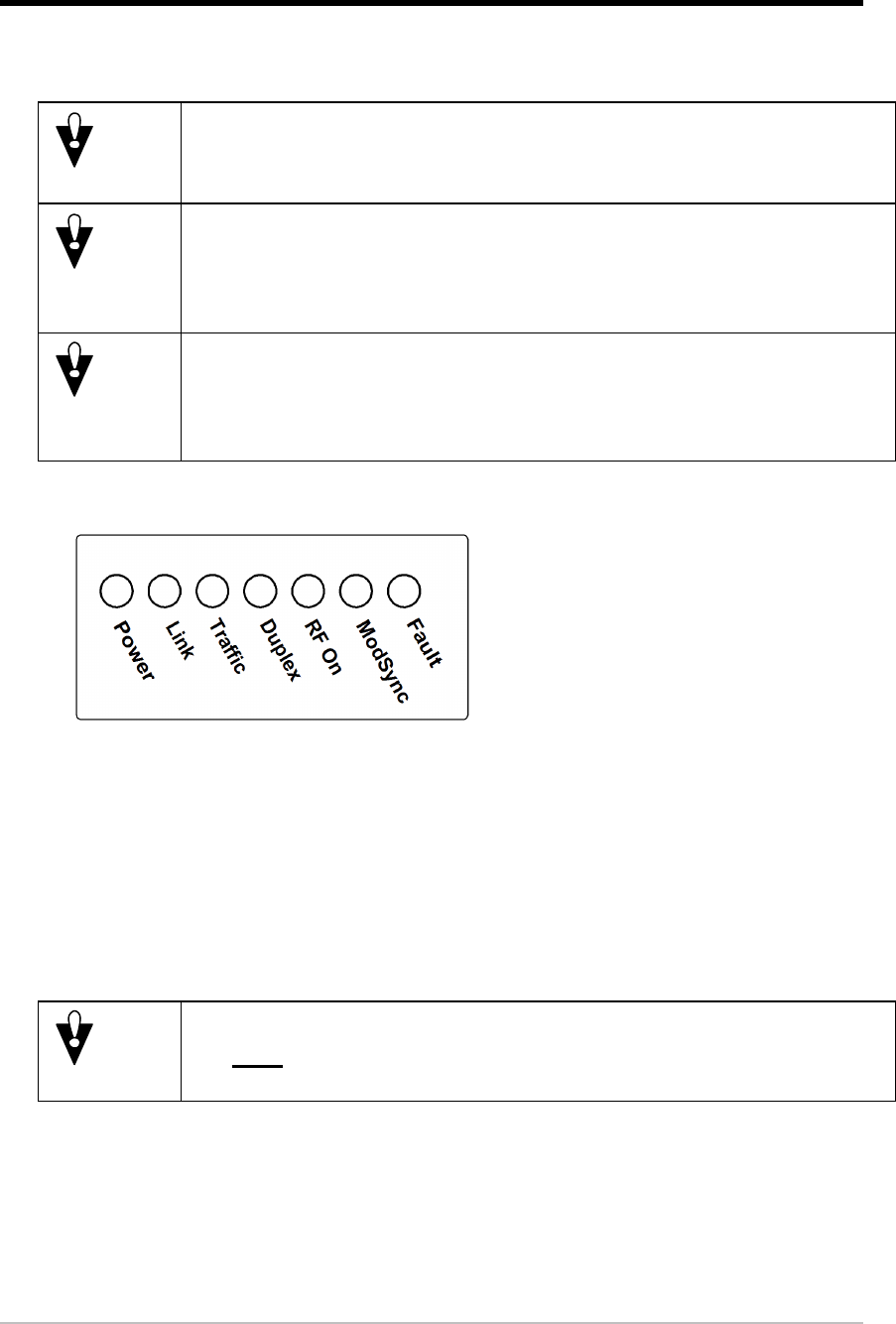
Installation of Radio and Antenna
45
Version 1.0
Procedure 6-5
Connect the power cable to the modem and the power pack
Caution
Install the Power cable only after proper grounding and
lightning protection has been established.
Caution
Connect the Airpair system to an Uninterruptable Power
Supply (UPS) or equivalent system in order to withstand
power outages.
Caution
Cables must have strain-relief support. Ensure cabling is
attached to tower or mast in a manner to provide maximum
strain relief.
Figure 6-6
6-LED Panel on Modem
Perform this procedure to connect the power cable between the modem and the
power pack.
1. Connect cable between modem and power pack.
2. Plug the power pack into the ac outlet.
3. Ensure the modem is receiving electrical power by viewing the Power LED on
the modem.
4. Ensure radio is receiving power. The RF On LED is lit on the modem.
5. Do NOT connect the CAT5 Ethernet cable to LAN equipment at this time.
Caution
Do NOT connect the CAT5 Ethernet cable to LAN equipment
at this time.
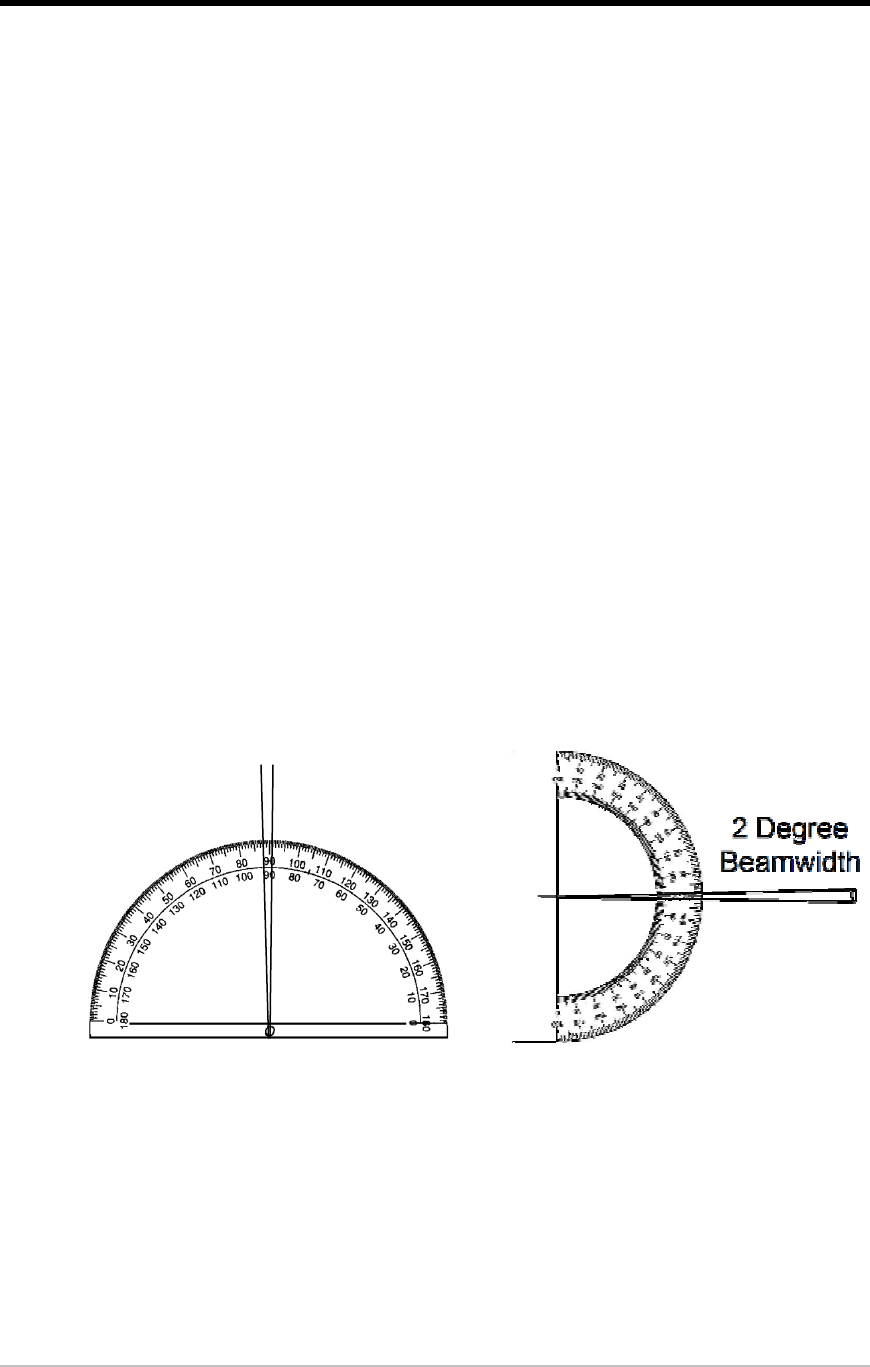
DragonWave Inc. 46
AirPair 100 UL 24 GHz Product Manual
6.3. Fine-adjust alignment of the radios
This section describes how to perform fine-adjust alignment of the radios. When
you prepare to align the radios, you must consider two important factors:
• Main Lobe and Side Lobes of Radio Waves
• Clear Line of Sight (LOS)
6.3.1. Main Lobe and Side Lobes of Radio Waves
When you align the radios, make sure you align to the Main Lobe of the
transmission. If you mistake a Main Lobe for a Side Lobe during installation,
there can be a 20-30 dB loss of signal strength. For example, if the Calculated
RSSI = -42 dB then the side lobe would be at approximately -62 dB, or 20 dB
lower than the calculated level.
The size of the beamwidth for the 24 GHz AirPair systems is approximately 2
degree, which is approximately equivalent to a thumb's width when the arm is
fully extended. Align as closely to the centre of the 2-degree beamwidth as
possible. It takes very little adjustment to swing past the main lobe, as can be
seen in Figure 6-7. A beamwidth of 2 degrees is narrow and alignment errors can
occur when you lock on to a Side Lobe instead of onto the Main lobe. If you align
to a Side Lobe and miss the Main Lobe, your signal strength is reduced. Make
sure you align the antenna to the Main Lobe.
Note: Verify the RSSI is within 2 dB of the calculated value.
Figure 6-7
2 Degree Beamwidth
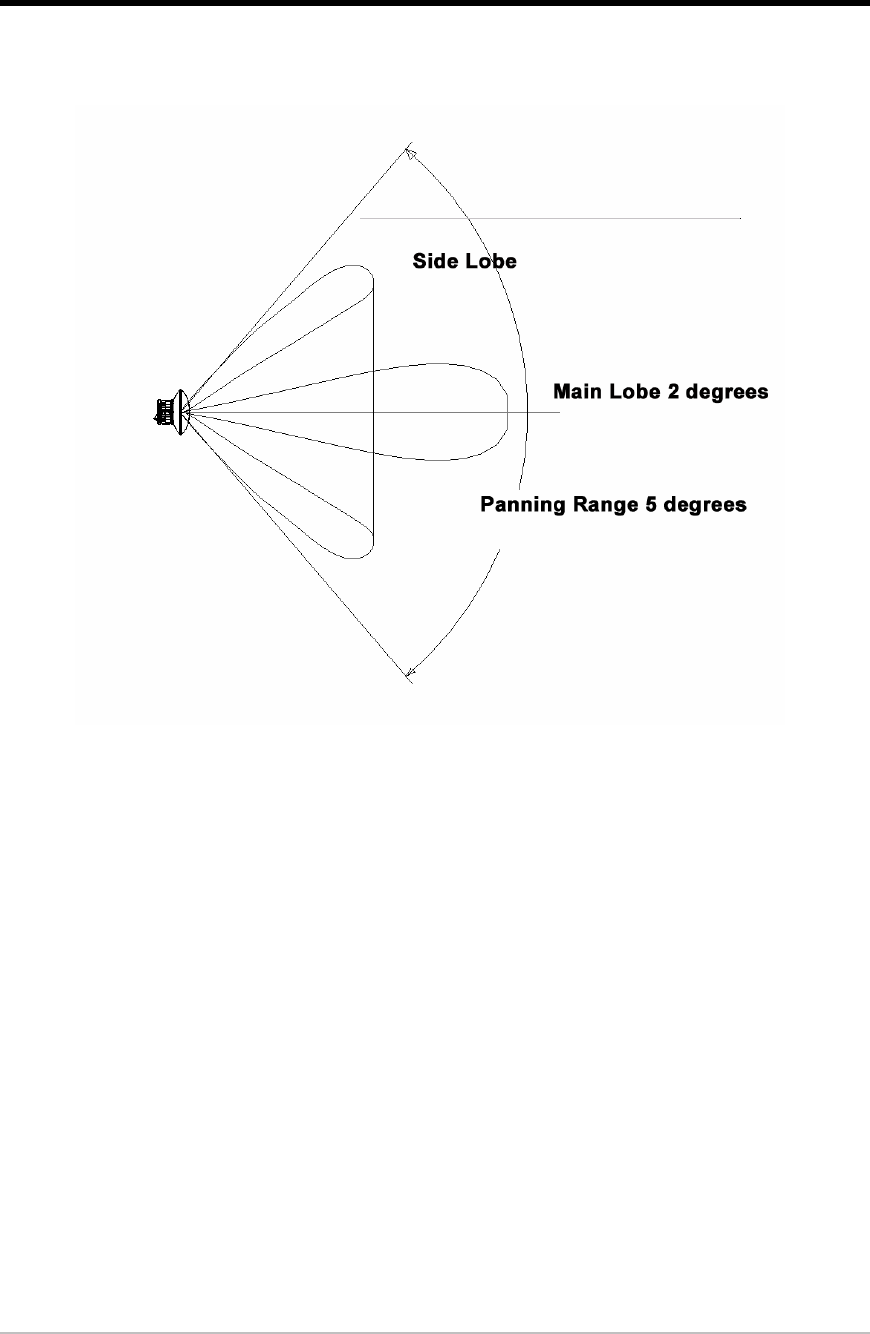
Installation of Radio and Antenna
47
Version 1.0
Figure 6-8
Main and Side Lobes - Radio Signal Using 12″/30 cm Antenna

DragonWave Inc. 48
AirPair 100 UL 24 GHz Product Manual
6.4. Clear Line of Sight
Caution
There can be no obstructions in the Fresnel zone. If there are
obstructions within this broad beam or Fresnel Zone, some
of the signal is diffracted off the obstruction, with an
accompanying phase shift.
The AirPair must have a clear line of sight. Use caution and make sure there is
proper Fresnel Zone clearance. The size of the beam grows as it propagates
towards the destination. The beam must have no obstructions in its path.
Obstructions within the path of the beam can decrease the signal quality by
diffracting the signal.
When you consider Fresnel Zone clearance, you must consider both the height
above and the lateral distance from obstructions Figure 6-9 show trees within the
Fresnel zone that obstruct the signal. Do not allow any obstruction of the Fresnel
Zone.
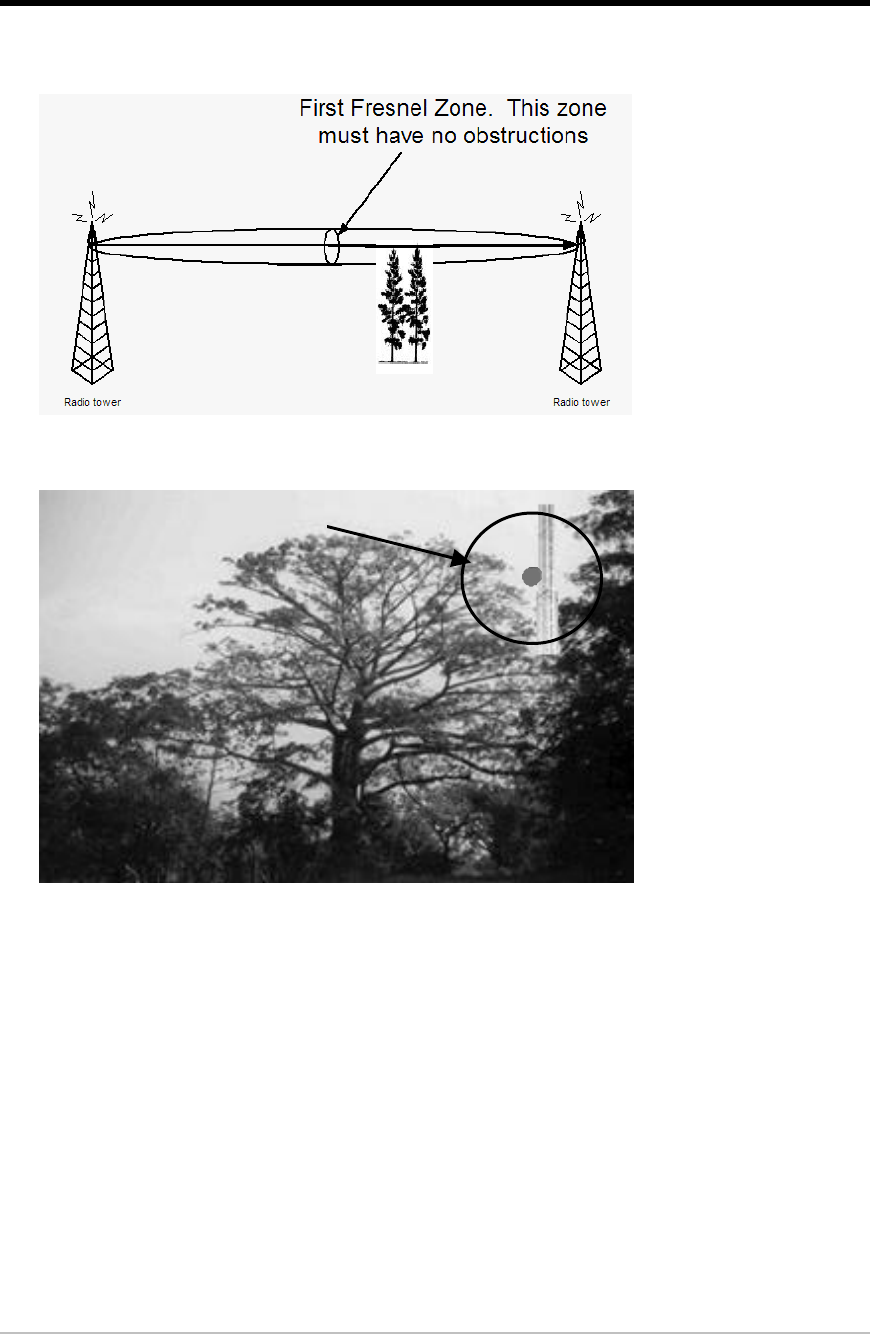
Installation of Radio and Antenna
49
Version 1.0
Figure 6-9
WRONG! Obstruction of the Fresnel Zone
Figure 6-10
WRONG! Trees within the Fresnel Zone Obstruct the Signal
Fresnel Zone

DragonWave Inc. 50
AirPair 100 UL 24 GHz Product Manual
6.5. Fine-adjust align the radios
Caution
Alignment of the radios requires power to be supplied to the
modem.
Caution
Proper alignment results in increased signal quality! Once
the radios have been visually aligned, fine adjust alignment
can begin. Pan across the entire beamwidth to ensure the
alignment corresponds to the Main Lobe and not to a Side
Lobe.
Caution
Transmission of radio signals results in a primary signal
(Main Lobe) and secondary signals (Side Lobes) being sent
towards the destination. During installation the Side Lobes
can be mistaken for the Main Lobe, resulting in a 20-30 dB
loss of signal strength. On a 12”/30 cm antenna, the entire
beamwidth typically lies within a 5 degree span so it is
critical to ensure alignment targets the Main Lobe and not
the Side Lobes. Larger antennas have a narrower beam. For
a 24”/60 cm antenna, the entire beamwidth lies within a 3
degree span.
Note: It is recommended that you use the DragonWave’s DragonPair PDA
software when aligning 24 GHz AirPair systems. DragonWave’s software runs on
a Personal Digital Assistant (PDA) with Palm OS V3.1 or higher. The software
provides an Antenna Alignment Indicator that shows relative signal strength. It
retains the peak value that was reached. This allows for multiple panning
attempts.
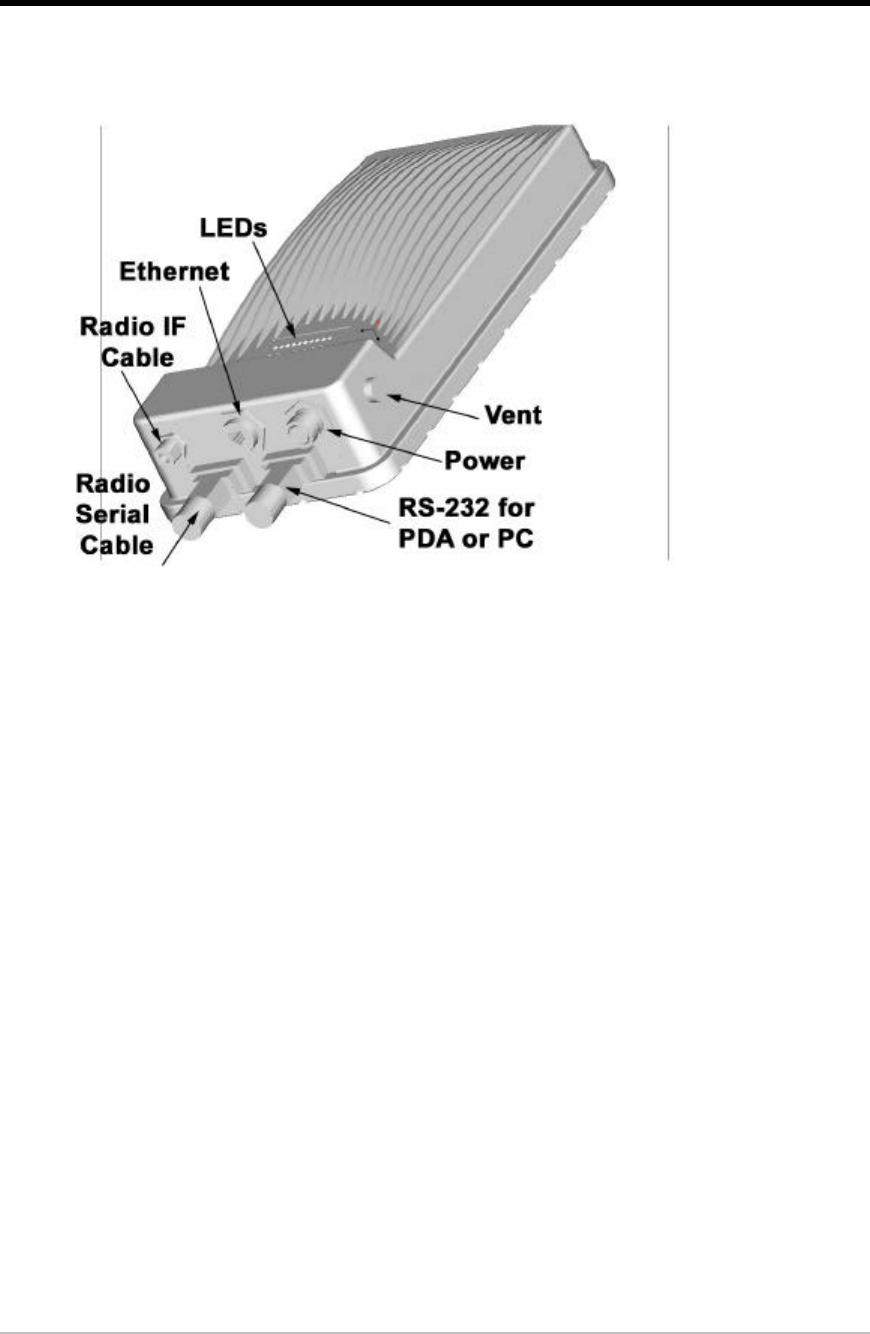
Installation of Radio and Antenna
51
Version 1.0
Figure 6-11
Modem
Procedure 6-6
Fine-adjust Align Radios
Use this procedure to fine-adjust the alignment of the radios.
At the first end:
(a) Pan or move the antenna horizontally at one end across the entire
beamwidth to identify the Main Lobe and the two side lobes. See Figure
6-8. Place a mark on the radio bracket to identify Main Lobe and each of
the Side Lobes. The Main Lobe is approximately 2 degrees in width. The
two Side Lobes are approximately 5 degrees apart.
(b) Tilt or move the antenna vertically and locate the strongest receive signal
reading.
(c) Pan or move the antenna horizontally and locate the strongest receive
signal reading.
(d) Tighten the bolt to lock the antenna in place.
At the other end:
(a) Pan or move the antenna horizontally at one end across the entire
beamwidth to identify the Main Lobe and the two side lobes.
(b) Tilt or move the antenna vertically and locate the strongest receive signal
reading.
(c) Pan or move the antenna horizontally and locate the strongest receive
signal reading.

DragonWave Inc. 52
AirPair 100 UL 24 GHz Product Manual
(d) Tighten the bolt to lock the antenna in place.
At the first end:
(a) Pan or move the antenna horizontally at one end across the entire
beamwidth to identify the Main Lobe and the two side lobes.
(b) Tilt or move the antenna vertically and locate the strongest receive signal
reading.
(c) Pan or move the antenna horizontally and locate the strongest receive
signal reading.
(d) Tighten the bolt to lock the antenna in place.
(e) Repeat these steps as necessary to obtain maximum signal strength.
Notes:
1. While Horizontal Alignment is being performed, ensure the Vertical Alignment
lockdown bolts are securely tightened to prevent movement, and vice versa
for Vertical Alignment.
2. The RSSI level should be within 2 dB of predicted levels. Factors that
contribute to low RSSI levels are:
• incorrect antenna alignment - aligned to side lobe and not main
lobe;
• improper polarization of antennas - horizontal vs. vertical.
• path issues
• obstructions such as trees, hills, or buildings within the beamwidth
• path clearance issues such as diffraction, partial obstruction, earth
curvature
3. Ensure alignment corresponds to the Main Signal Lobe and not to the Side
Lobes.
4. The connectors (Power cable, IF cable, Serial cable, and Ethernet cable) on
the AirPair units are of a weatherproof design. Sealing of connectors is not
necessary.
5. Once the radios and modems have been installed and aligned, you need to
ensure that the grounding cables at the radio and modem are properly sealed
using potting compound, rubberized tape or other waterproof material. Cable
corrosion can result in decreased quality of grounding connections, and
therefore present greater risk of personal or equipment damage during
lightning strikes.
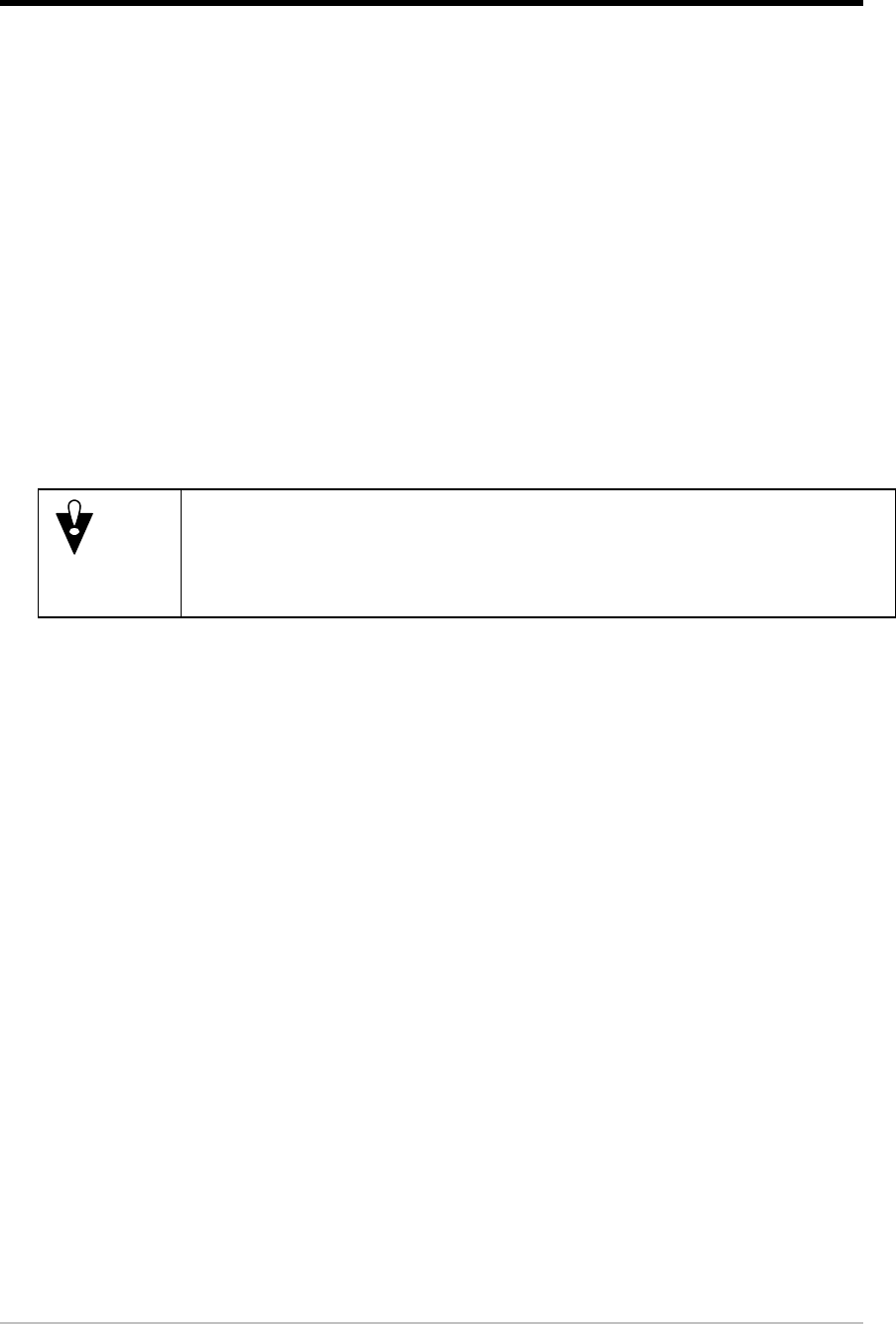
Installation of Radio and Antenna
53
Version 1.0
6.5.1. Perform a Data Test
This section describes how to perform a data test.
Procedure 6-7
Perform a data test
Perform this procedure to confirm the network link is working properly. It is
assumed that you are using an Ethernet traffic-generating device.
1. Connect the device to the Ethernet cable at either end.
2. Confirm data can be passed within desired error rates. This will ensure the
network link is working in a satisfactory manner prior to running applications
over the link.
6.5.2. Connect to the LAN
This section describes how to connect the system to the LAN with an Ethernet
cable.
Caution
The Ethernet Cable is meant to be connected to a Server and
therefore the signal pairs on the cable must be switched in
order to connect to a router or a switch.
Once alignment, sealing of cables and data test have been completed, connect
the Ethernet cable to your network device.
Ensure optimum throughput. The Ethernet connection to the modem is intended
to operate at 100 Mbps Full Duplex for AirPair 100 and at 50 Mbps Full Duplex
for AirPair 50.

DragonWave Inc. 54
AirPair 100 UL 24 GHz Product Manual
This page is intentionally left blank.

7. Setting up the SNMP
Procedure 7-1
Setting up SNMP
Perform this procedure to set up SNMP for the AirPair.
Required Action Steps
telnet Telnets to the AirPair.
set snmp access mode
[v1/v2c/off] Selects a mode.
Sequence:
set snmp access mode [v1/v2c/off] press Enter
The system responds:
SNMP Mode: [v1 | v2c | off]
set snmp set request [on/off] Sets the SNMP access on. This allows SNMP v1 and v2c ‘Set’
requests.
Sequence:
set snmp set request [on/off] press Enter
The system responds:
SNMP Set Requests are [on/off].
get snmp set request Displays SNMP requests on. Shows if SNMP v1 and v2c ‘Set’
requests are enabled. The default is off.
Sequence:
get snmp set requests press Enter
The system responds:
SNMP Set Requests are [on | off].
get snmp managers Displays a list of managers that can access the system via SNMP.
Sequence:
get snmp managers press Enter
The system responds:
Mgr # IpAddress/ CommunityString

DragonWave Inc. 56
AirPair 100 UL 24 GHz Product Manual
Required Action Steps
1 192.168.1.133 example text1
2 192.168.1.100 example text2
If there are no managers specified, the system responds:
No managers configured for the system.
set snmp manager [mgr#] [ip
address] [enable/disable]
[community string]
Specifies the SNMP managers to allow access to the system.
Sequence:
set snmp manager [mgr#] [ip address] [enable/disable]
[community string] press Enter
The system responds:
Mgr# IpAddress Status CommunityString
1 192.7.1.1 disabled public
2 0.0.0.0 disabled public
3 0.0.0.0 disabled public
4 0.0.0.0 disabled public
5 0.0.0.0 disabled public
6 any disabled public
Note 1: Only maximum of 5 managers are allowed. If all the
managers are filled in, remove 1 manager by overwriting the
particular index.
Note 2: By setting the IP address of last index to 'any' and
'enable', anybody can have access to the system via SNMP.
set SysContact Sets System contact to allow access MIB objects via an SNMP
browser. For example, you can set the sysContact in MIB-II (RFC
1213) using your MIB browser, e.g., HP OpenView Node Manager.
save mib Saves the MIB to FLASH. Perform this command save setting
changes to FLASH. This command does not restart the system and
does not put any new settings into effect.
Sequence:
save mib press Enter
The system responds:
Mib saved successfully.

Setting Up SNMP
57
Version 1.0
7.1.1. AirPair Enterprise Management Information Base
A Management Information Base (MIB) contains information about a network device that
is managed by SNMP. AirPair supports industry standards MIB I and MIB II. In addition,
DragonWave provides an enterprise MIB for AirPair. For a list of objects and their
definitions refer to the AirPair MIB definition file on the DragonWave Toolkit CD-ROM.
You must load the AirPair MIB onto your own MIB browser or Network Management
Station (NMS). HP OpenView is an example of network management software to be
used on the NMS. The AirPair Enterprise MIB is provided in a standard MIB format that
allows a more direct method of loading the definitions onto the NMS. On some NMS
systems, it is as straight-forward as placing the AirPair MIB into the proper NMS
directory and then enabling it by adding it to the MIB list. Please consult the instructions
provided with your NMS for details on loading the Enterprise MIBs.
7.1.2. Traps
A trap is a message that reports a problem or a significant event. Traps are defined in
AirPair MIB definition file. For a complete list of traps, refer to the MIB definition file on
the AirPair Toolkit CD-ROM.
Procedure
7-2 Enable traps
Perform this procedure to enable traps.
Required Action Steps
telnet Telnet to the AirPair.
Note: You may also connect using a serial cable.
get snmp trap hosts Displays a list of receivers of SNMP traps.
Sequence:
get snmp trap hosts press Enter
The system responds:
Host# IpAddress Status CommunityString
1 0.0.0.0 disabled public
2 0.0.0.0 disabled public
3 0.0.0.0 disabled public
4 0.0.0.0 disabled public
5 0.0.0.0 disabled public
Note: A maximum of 5 hosts is allowed. If all the hosts are filled in,
remove 1 host by overwriting the particular index.
set snmp trap host [host #]
[ipAddress] [enable/disable] Adds an SNMP trap host to the list of receivers of SNMP traps. Specify
the IP address where the system sends traps.

DragonWave Inc. 58
AirPair 100 UL 24 GHz Product Manual
Required Action Steps
[communityString]
Sequence:
set snmp trap host [host #] [ipAddress] [enable/disable]
[communityString] press Enter
The system responds:
Host# IpAddress Status CommunityString
1 0.0.0.0 disabled public
2 0.0.0.0 disabled public
3 3.3.3.3 enabled new text string here
4 0.0.0.0 disabled public
5 0.0.0.0 disabled public
Note: A maximum of 5 hosts are allowed. If all the hosts are filled
in, remove 1 host by overwriting the particular index.
get snmp traps Displays the list of traps that are available in the system.
Sequence:
get snmp traps press Enter
The system responds:
Trap# TrapName Enabled(Yes | No)
1 ColdStart No
2 WarmStart No
3 Link down No
4 Link up No
5 Explicit Authentication Failure No
6 AutoNeg Mismatched Duplex No
7 LossOfSignalLockFromDemod No
8 BerThresholdExceeded No
9 Mod PLL lock failure No
10 Mod loss of sync bytes No
11 Mod input FIFO overrun/underrun No
12 Mod input data inactivity No
13 SNR below threshold No
14 PLDRO lost lock No
15 Radio lost comm No
16 Radio mismatch No
17 IF Tx Synth Unlocked No
18 IF Rx Synth Unlocked No
set snmp trap [trapIndex]
[enable/disable] Sets the SNMP trap and enables or disables it. DragonWave
recommends enabling the LossOfSignalLockFromDemod trap. This
trap indicates loss of communication with the peer AirPair node.

Setting Up SNMP
59
Version 1.0
Required Action Steps
Sequence:
set snmp trap [trapIndex] [enable/disable] press Enter
The system responds:
Trap# TrapName Enabled(Yes | No)
1 ColdStart No
2 WarmStart No
3 Link down No
4 Link up No
5 Explicit Authentication Failure No
6 AutoNeg Mismatched Duplex No
7 LossOfSignalLockFromDemod No
8 BerThresholdExceeded No
9 Mod PLL lock failure No
10 Mod loss of sync bytes No
11 Mod input FIFO overrun/underrun No
12 Mod input data inactivity No
13 SNR below threshold No
14 PLDRO lost lock No
15 Radio lost comm No
16 Radio mismatch No
17 IF Tx Synth Unlocked No
18 IF Rx Synth Unlocked No
reset system Resets the system to save the settings to FLASH and restarts the
system with the new settings taking effect. If you do not wish to restart
the system, use the command save MIB to save the settings to
FLASH.
Sequence:
Reset system press Enter
The system responds:
System reset.

DragonWave Inc. 60
AirPair 100 UL 24 GHz Product Manual
This page is intentionally left blank.

8. Technical Support
DragonWave provides technical support on all products shipped to Customers. Our
Technical Support centre provides support 7 days a week and 24 hours per day. The
centre is staffed by the DragonWave technical support during normal office hours,
(Monday – Friday between 9:00 AM and 5:00 PM Eastern Standard Time). After hours
the calls are routed to a cell phone / pager to reach the technical support engineer on
call.
The contact details for DragonWave Technical Support are as follows:
Telephone: (613) 271 - 7010
Fax: (613) 599 – 4225
Email : Support@Dragonwaveinc.com
Web Site: http://www.dragonwaveinc.com/contactus/support
Or http://support.dragonwaveinc.com

DragonWave Inc. 62
AirPair 100 UL 24 GHz Product Manual
This page is intentionally left blank.

9. Notice
Information contained in this document is subject to change without notice. DragonWave
Inc. shall not be liable for errors contained herein or for incidental or consequential
damages in connection with the furnishings, performance, or use of the material.
9.1. Copyright
© Copyright 2000-2003 by DragonWave Inc. All rights reserved. This document contains
confidential information, which is proprietary to DragonWave Inc. No part of this
publication can be reproduced or transmitted in any form or by any means, electronic or
mechanical, including photocopying and recording, or by any information storage or
retrieval system, without prior written consent from DragonWave Inc.
The DragonWave logo and design, DragonWave, AirPair and DragonLink are
trademarks of DragonWave Inc. Other brand names used in this publication are
trademarks or registered trademarks of their respective owners.

DragonWave Inc. 64
AirPair 100 UL 24 GHz Product Manual
This page is intentionally left blank.
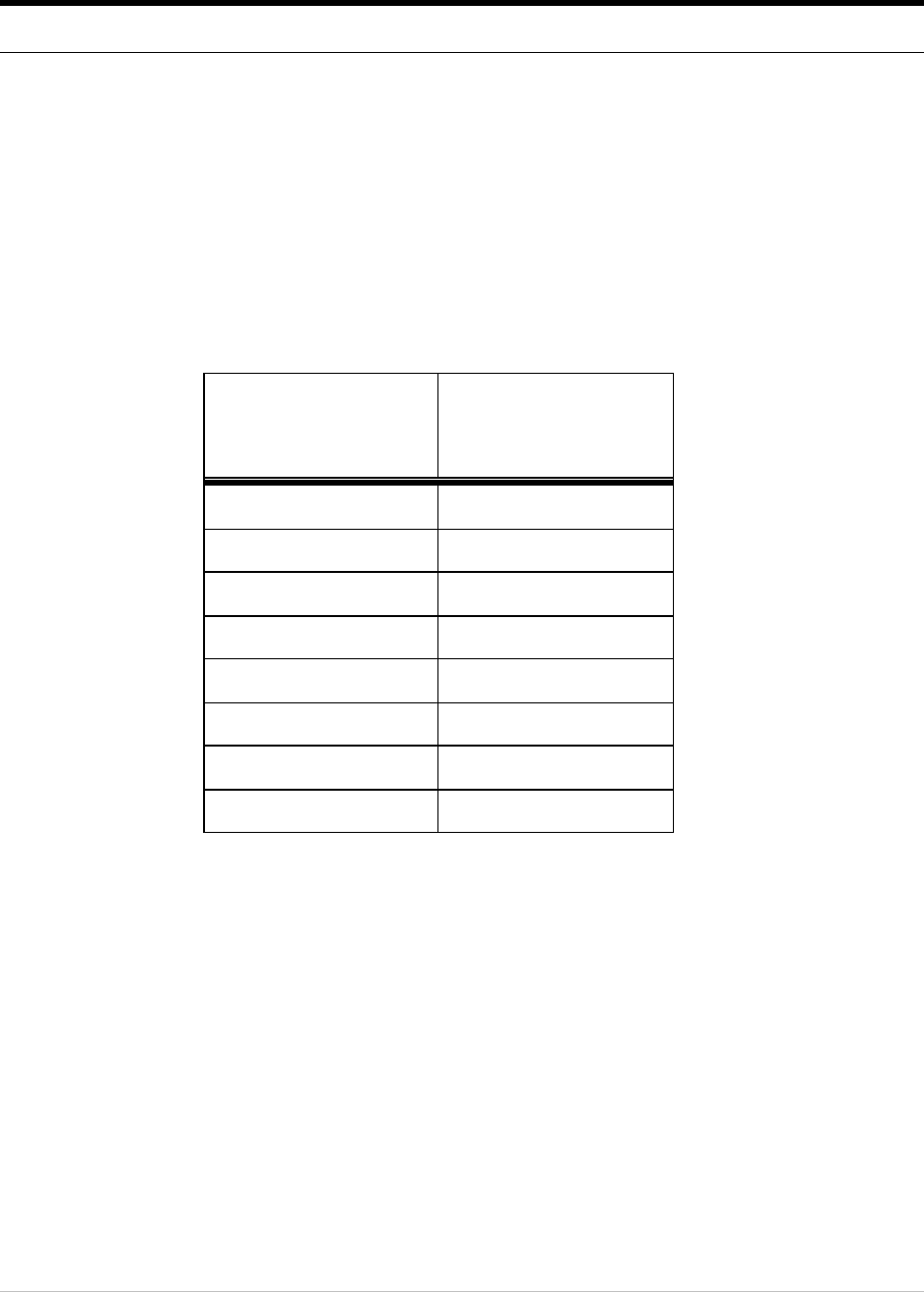
Appendix A – Frequency Channel Plans
This appendix describes frequency channel plans.
Table A- 1 lists the FCC Channel Plans for 24 GHz.
Note: Either of the two radios may be programmed at the GO frequency. The other
radio must then be programmed at the matching RETURN frequency for coupled
(paired) operation. Therefore, using the table below, if one radio is set to transmit at
24080 MHz, then other radio must be set to transmit at 24150 MHz. Refer to the section
below for decoupled (unpaired) operation.
Table A- 1
Available Standard Frequencies
GO
Frequency
(MHz)
RETURN
Frequency
(MHz)
24080 24150
24090 24160
24100 24170
24110 24180
24120 24190
24130 24200
24140 24210
24150 24220
Should many 24 GHz systems be deployed in the same small geographical footprint,
then DragonWave’s 24 GHz system allows full control of the frequencies. Normally, the
frequencies are paired according to the table above, however unpaired frequency
operation is allowed.
Note the frequencies must differ by a minimum of 70 MHz. For example, if one radio is
set to a frequency of 24080 MHz, then the other radio must be set to a minimum offset of
70 MHZ and therefore must be set to 24150 MHz or higher. There are no other
restrictions on frequency selection that is to say that any frequency combinations may be
selected as long as the spacing is a minimum of 70 MHz. Therefore, if one radio is set
to 24150 MHz then the other radio may be set to a frequency of 70 MHz higher (24220
MHz), or 70 MHz lower (24080 MHz).
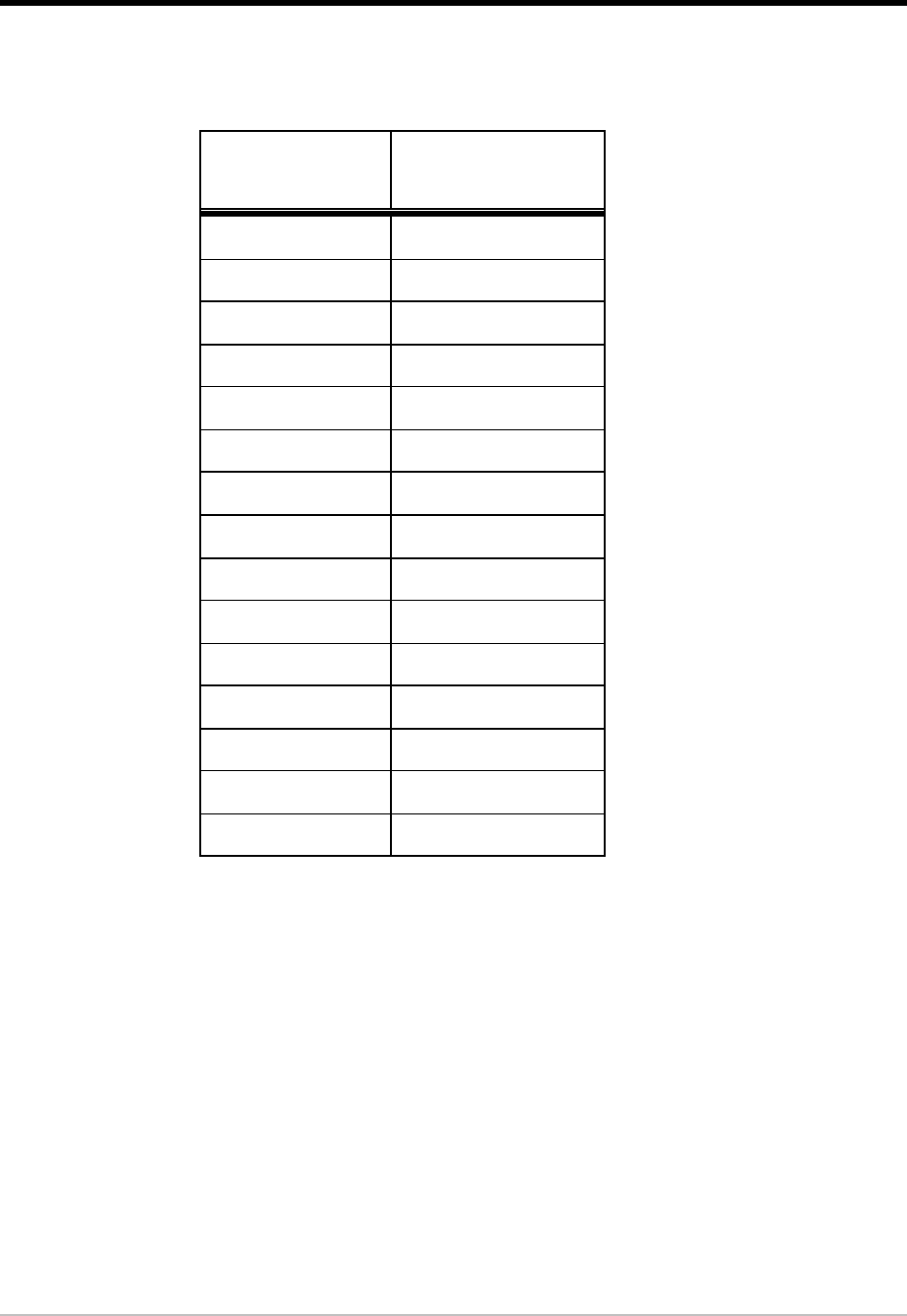
DragonWave Inc. 66
AirPair 100 UL 24 GHz Product Manual
Table A- 2
Available Customized Frequencies
Frequency
(MHz)
DragonWave
Channel
24080 UNL1
24090 UNL2
24100 UNL3
24110 UNL4
24120 UNL5
24130 UNL6
24140 UNL7
24150 UNL8
24160 UNL9
24170 UNL10
24180 UNL11
24190 UNL12
24200 UNL13
24210 UNL14
24220 UNL15

Appendix B – Mounting Instructions for 30 CM, 45 CM, 60
CM, 90cm, 120 cm Antennas
See the appropriate Antenna Mounting Instructions Manual. The Mounting Instruction
Manual is shipped in the box with the mounting equipment and antenna.
Copyright © 2000-2003 DragonWave Inc. All rights reserved.
Visit us on the Internet at:
http://www.dragonwaveinc.com/